The Alocasia is a striking leaf ornamental plant that has long since moved into our homes. It comes along with its long petioles and immediately captivates the viewer. In this blog post, you’ll learn everything you need to know about Alocasia varieties.
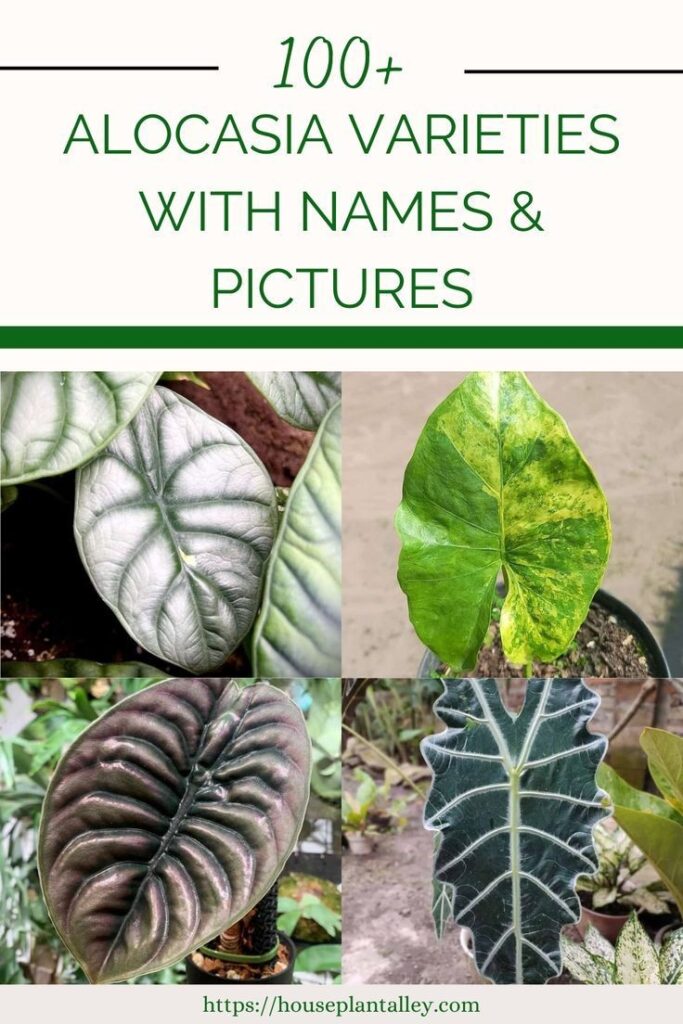
Contents
- 1 About Alocasias
- 2 Alocasia Varieties With Names and Pictures
- 2.1 Alocasia acuminata
- 2.2 Alocasia aequiloba
- 2.3 Alocasia aequiloba ‘Gold Dust’
- 2.4 Alocasia alba
- 2.5 Alocasia alba ‘Silver’
- 2.6 Alocasia ‘Albatuwan’
- 2.7 Alocasia ‘Amazonica’
- 2.8 Alocasia arifolia
- 2.9 Alocasia atropurpurea
- 2.10 Alocasia ‘Aurora’
- 2.11 Alocasia azlanii
- 2.12 Alocasia baginda
- 2.13 Alocasia baginda ‘Dragon Scale’
- 2.14 Alocasia baginda ‘Green Dragon’
- 2.15 Alocasia baginda ‘Silver Dragon’
- 2.16 Alocasia balgooyi
- 2.17 Alocasia ‘Bambino Arrow’
- 2.18 Alocasia beccarii
- 2.19 Alocasia ‘Bisma’
- 2.20 Alocasia boa
- 2.21 Alocasia boyceana
- 2.22 Alocasia brancifolia
- 2.23 Alocasia brisbanensis
- 2.24 Alocasia cadieri
- 2.25 Alocasia celebica
- 2.26 Alocasia chaii
- 2.27 Alocasia chienlii
- 2.28 Alocasia clypeolata
- 2.29 Alocasia ‘Corazon’
- 2.30 Alocasia cucullata
- 2.31 Alocasia cucullata ‘Banana Split’
- 2.32 Alocasia cucullata ‘Crinkles’
- 2.33 Alocasia cucullata ‘Moon Landing’
- 2.34 Alocasia cucullata ‘Yellow Tail’
- 2.35 Alocasia culionensis
- 2.36 Alocasia cuprea
- 2.37 Alocasia decipiens
- 2.38 Alocasia devansayana
- 2.39 Alocasia fallax
- 2.40 Alocasia farisii
- 2.41 Alocasia flemingiana
- 2.42 Alocasia fornicata
- 2.43 Alocasia ‘Frydek-Bullata’
- 2.44 Alocasia gageana
- 2.45 Alocasia ‘Golden Bone’
- 2.46 Alocasia heterophylla
- 2.47 Alocasia heterophylla ‘Green Veins’
- 2.48 Alocasia heterophylla ‘Green’
- 2.49 Alocasia heterophylla ‘Silver Kris’
- 2.50 Alocasia heterophylla ‘Silver’
- 2.51 Alocasia hollrungii
- 2.52 Alocasia hypoleuca
- 2.53 Alocasia indica
- 2.54 Alocasia infernalis
- 2.55 Alocasia inornata
- 2.56 Alocasia ‘Kalila’
- 2.57 Alocasia ‘Katya’
- 2.58 Alocasia kerinciensis
- 2.59 Alocasia ‘Kulat’
- 2.60 Alocasia lancifolia
- 2.61 Alocasia lauterbachiana
- 2.62 Alocasia ‘Lukiwan’
- 2.63 Alocasia maquilingensis
- 2.64 Alocasia melo
- 2.65 Alocasia micholitziana
- 2.66 Alocasia micholitziana ‘Frydek’
- 2.67 Alocasia micholitziana ‘Maxkowskii’
- 2.68 Alocasia minuscula
- 2.69 Alocasia monticola
- 2.70 Alocasia navicularis
- 2.71 Alocasia nebula
- 2.72 Alocasia nicolsonii
- 2.73 Alocasia nycteris
- 2.74 Alocasia odora
- 2.75 Alocasia odora ‘Blue’
- 2.76 Alocasia odora ‘Indian’
- 2.77 Alocasia odora ‘Okinawa Silver’
- 2.78 Alocasia pangeran
- 2.79 Alocasia ‘Pasappa’
- 2.80 Alocasia peltata
- 2.81 Alocasia peltata ‘Silver Grey’
- 2.82 Alocasia perakensis
- 2.83 Alocasia perakensis ‘Silver Giant’
- 2.84 Alocasia portei
- 2.85 Alocasia ‘Prince of Curup’
- 2.86 Alocasia princeps
- 2.87 Alocasia princeps ‘Candy Sticks’
- 2.88 Alocasia princeps ‘Purple Cloak’
- 2.89 Alocasia principiculus
- 2.90 Alocasia ‘Pseudo Sanderiana’
- 2.91 Alocasia puber
- 2.92 Alocasia ramosii
- 2.93 Alocasia reginae
- 2.94 Alocasia reginae ‘Elaine’
- 2.95 Alocasia reginae ‘Miri’
- 2.96 Alocasia reginula
- 2.97 Alocasia reginula ‘Black Ninja’
- 2.98 Alocasia reginula ‘Black Velvet’
- 2.99 Alocasia reginula ‘Silver Velvet’
- 2.100 Alocasia reverse
- 2.101 Alocasia ridleyi
- 2.102 Alocasia rivularis
- 2.103 Alocasia robusta
- 2.104 Alocasia salarkhanii
- 2.105 Alocasia sanderiana
- 2.106 Alocasia sarawakensis
- 2.107 Alocasia ‘Sarian’
- 2.108 Alocasia scabriuscula
- 2.109 Alocasia scalprum
- 2.110 Alocasia ‘Serendipity’
- 2.111 Alocasia simonsiana
- 2.112 Alocasia sinuata
- 2.113 Alocasia suhirmaniana
- 2.114 Alocasia tandurusa
- 2.115 Alocasia venusta
- 2.116 Alocasia vietnamensis
- 2.117 Alocasia wentii
- 2.118 Alocasia wongii
- 2.119 Alocasia yunqiana
- 2.120 Alocasia zebrina
- 3 Alocasia Plant Care Guide
About Alocasias
Alocasias grow naturally in the tropical rainforests of Asia and Australia. There, the leaves of the Alocasia are also used to hide during a rain shower. Because the leaves grow so large, the Alocasia is also called Elephant Ear. In the wild, an Alocasia can–depending on the species–grow up to a few meters high and therefore not all species are suitable as a houseplant.
With about 80 different species of alocasias, everyone will find what they are looking for. The leaves are as different as they could be. Not every one of these species is suitable as a houseplant, which limits the selection somewhat.
The leaf shape always has the arrowhead shape as a basis, even if this is sometimes somewhat rounder or wavy. Some species have deeply incised leaves and are therefore hardly recognizable as an Alocasia.
Related Posts:
Is Alocasia Pet Friendly?
Alocasia vs Colocasia
Alocasia Varieties With Names and Pictures
Within the group Alocasia, in addition to the varieties best known for their large green leaves, there are others not so famous but equally interesting. Here are all the Alocasia varieties with names and pictures for identification!
Alocasia acuminata
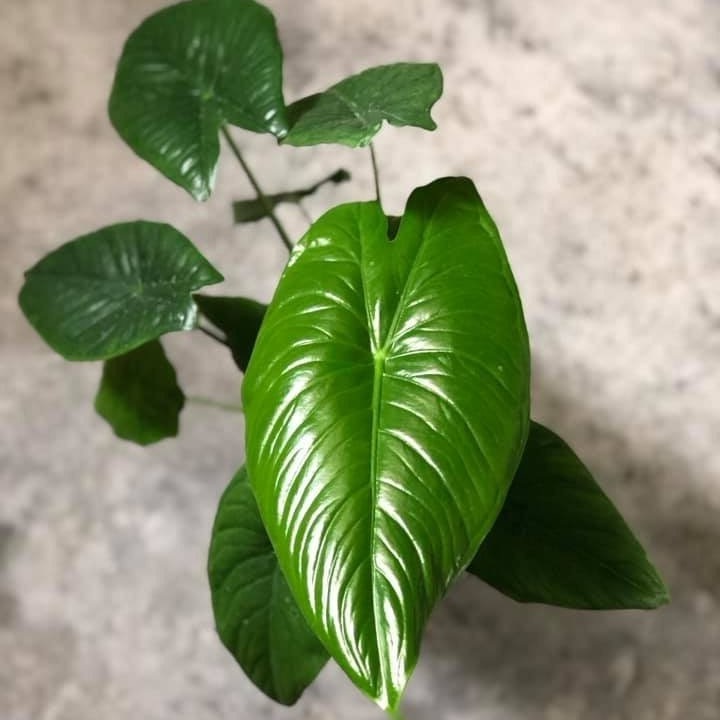
This little guy only grows about 2-2.5 feet tall. It has upright stems that eventually lean over, covered in old leaf bases. There are usually around 5 leaves that are a vibrant green color and lance-shaped. This variety is found in places like Thailand, India, Nepal, and parts of China at elevations between 2,100-3,900 feet. It likes moist forests and sometimes even grows on limestone or granite!
Alocasia aequiloba

Moderate in size, this one has stems that lean over or creep along the ground, rarely standing up straight. The leaves can be spearhead or arrowhead shaped, with glossy dark green tops and dull pale undersides. Some even have yellow or white speckles! Older leaves often have mosses and lichens growing on them. You can find this variety in northern New Guinea and the Bismarck Islands, living on rainforest floors.
Alocasia aequiloba ‘Gold Dust’

Alocasia aequiloba ‘Gold Dust’ is a cultivar of Alocasia aequiloba characterized by irregular gold spots on its leaves.
Alocasia alba

This robust plant can reach up to 6.5 feet tall! It has several leaves, with the upper ones green and the lower ones more yellowish-green. The leaf shapes range from oblong to arrowhead. Found in parts of Indonesia like Java and Sumatra, it grows in shady forests, along roads, on river banks, and in open lowland areas. A few special features are the non-peltate (not shield-shaped) leaves, veins that really stand out on the underside, and green spathes.
Variegated Alocasia alba:


Alocasia alba ‘Silver’

Alocasia alba ‘Silver’ is a cultivar of Alocasia alba that exhibits whitish-silvery leaves, compared to the solid green of the Alocasia alba type species.
Alocasia ‘Albatuwan’

Alocasia ‘Albatuwan’ is a hybrid between Alocasia alba and Alocasia reginae. It was first hybridized by Wawan at the Chong Lee Nursery in Malaysia, where he worked between 2001 and 2016.
During his time in Kalimantan, Wawan acquired a plant he called Alocasia ‘Batu’, a plant later revealed to be Alocasia reginae. He hybridized it with Alocasia alba and named it ‘Albatuwan’: Alba + Batu + Wan (Wan comes from his name Wawan). It is more common in Malaysia, and less commonly exported to Thailand and Indonesia.
Alocasia ‘Amazonica’

Don’t let the name fool you – this hybrid doesn’t actually come from the Amazon! It’s a cross between sanderiana and longiloba ‘Watsoniana’ varieties created by a nursery. People sometimes mix it up with a smaller version called ‘Polly’.
Alocasia arifolia

This one only grows about 2 feet tall. It has an upright to leaning stem around 1 foot long. Usually there are several leaves that are around 1 foot in length with an arrowhead or spearhead shape. They have a glossy, mid-to-dark green color and a paperlike or thin leathery texture. You can find this variety in the forests of Sumatra, Indonesia at elevations between 1,300-4,300 feet, often near streams.
Alocasia atropurpurea

Moderately large, this herb has papery, egg-to-arrowhead shaped leaves about 16 inches long that are very shallowly peltate (like a small shield). The leaves have major veins on each side and minor veins branching off but not quite connecting. It’s found in northern Luzon, Philippines growing in open, limestone areas.
Alocasia ‘Aurora’

No one is totally sure about the parentage of this natural hybrid. The original plant was bought at a Thai flower market and later became the first in the popular Safari Series. It’s also known as ‘Pink Dragon’ in Europe. Maybe you can spot one with its vibrant coloring!
Alocasia azlanii

This little herb has very slender stems only about half an inch wide with internodes almost as long. It has a few leaves that are a broad oval shape, around 6-8 inches long and 3-4 inches wide. The tops are a dark coppery purple-green while the undersides are pale green. You’ll find it on the island of Borneo growing along shaded, moist riverbanks.
Alocasia baginda

This small but sturdy plant only grows 10-12 inches tall. Its stem starts upright but eventually leans over. It usually has 4 spreading leaves with petioles (leaf stems) that are 5-9 inches long and pale green with white speckles near the bottom. The leaf blades are very broadly egg-shaped to circular, with a leathery, matte dark green top and contrasting pale gray puffed-up portions defined by the veins. You’ll find this variety on the island of Borneo.
Alocasia baginda ‘Dragon Scale’

Alocasia baginda ‘Dragon Scale’ is a cultivar of Alocasia baginda that exhibits darker, fully green leaf surfaces, compared to the more muted Alocasia baginda type species.
Alocasia baginda ‘Green Dragon’

Alocasia baginda ‘Green Dragon’ is a cultivar of Alocasia baginda that exhibits some of the lighter silvery feathering patterns on the upper leaf surfaces, similar to the Alocasia baginda type species, along with the deeper green leaf surface reminiscent of Alocasia baginda ‘Dragon Scale’.
Alocasia baginda ‘Silver Dragon’

Alocasia baginda ‘Silver Dragon’ is a cultivar of Alocasia baginda that exhibits silver interveinal coloration (varies in strength with available light levels) on the upper leaf surfaces, while maintaining the dark green vein coloration reminiscent of Alocasia baginda ‘Dragon Scale’.
Alocasia balgooyi

Now this is a massive plant, growing 3-10 feet tall! It has a large, thick rhizome (underground stem) covered in fibrous remnants of old leaves. The few leaves it produces range from egg-shaped to arrowhead-shaped, and can be 20-39 inches long with a papery texture. Found in Sulawesi, Indonesia, it prefers rocky, swampy, or disturbed forest areas up to 4,000 feet elevation.
Alocasia ‘Bambino Arrow’

This fun little Dutch hybrid, introduced around 2008, is probably a mixture of the longiloba variety. Its compact size makes it great for gardens or pots.
Alocasia beccarii

At just 5-11 inches tall, this little guy from Borneo has a very slender stem less than half an inch wide. It produces several narrowly elliptic to tear-drop shaped leathery leaves up to 7 inches long in a mid-green color. You’ll find it growing low among boulders over sandstone.
Alocasia ‘Bisma’
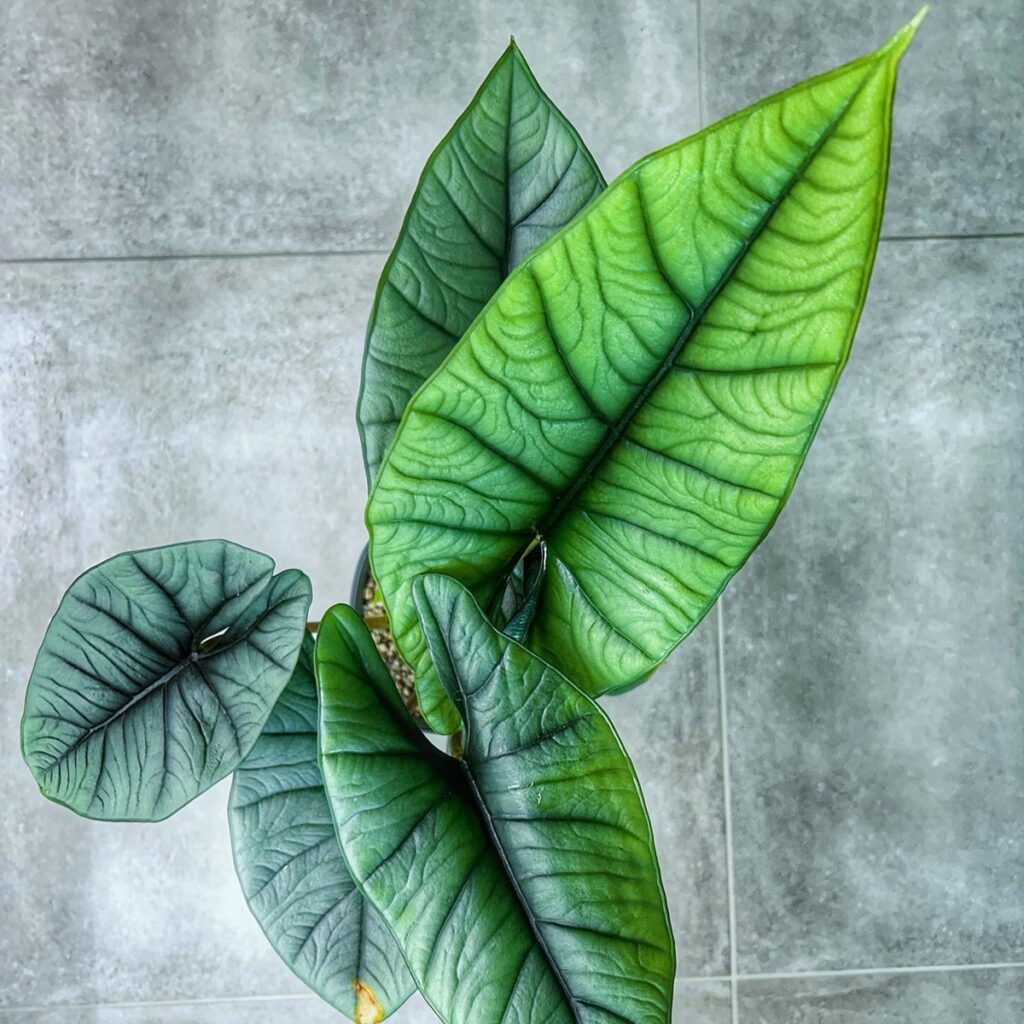
Alocasia ‘Bisma’ has a really cool name! ‘Bisma’ comes from the Urdu word meaning ‘caregiver’, ‘polite’, ‘obedient’ or ‘significant’. In some cultures, it’s a popular name given to girls. Pretty neat that this unique alocasia variety carries such a meaningful moniker, right? The name makes it sound like a true gem among plants – maybe it has an extra special quality that earns it that ‘significant’ title. Either way, ‘Bisma’ is one variety with a name you won’t forget!
Alocasia boa
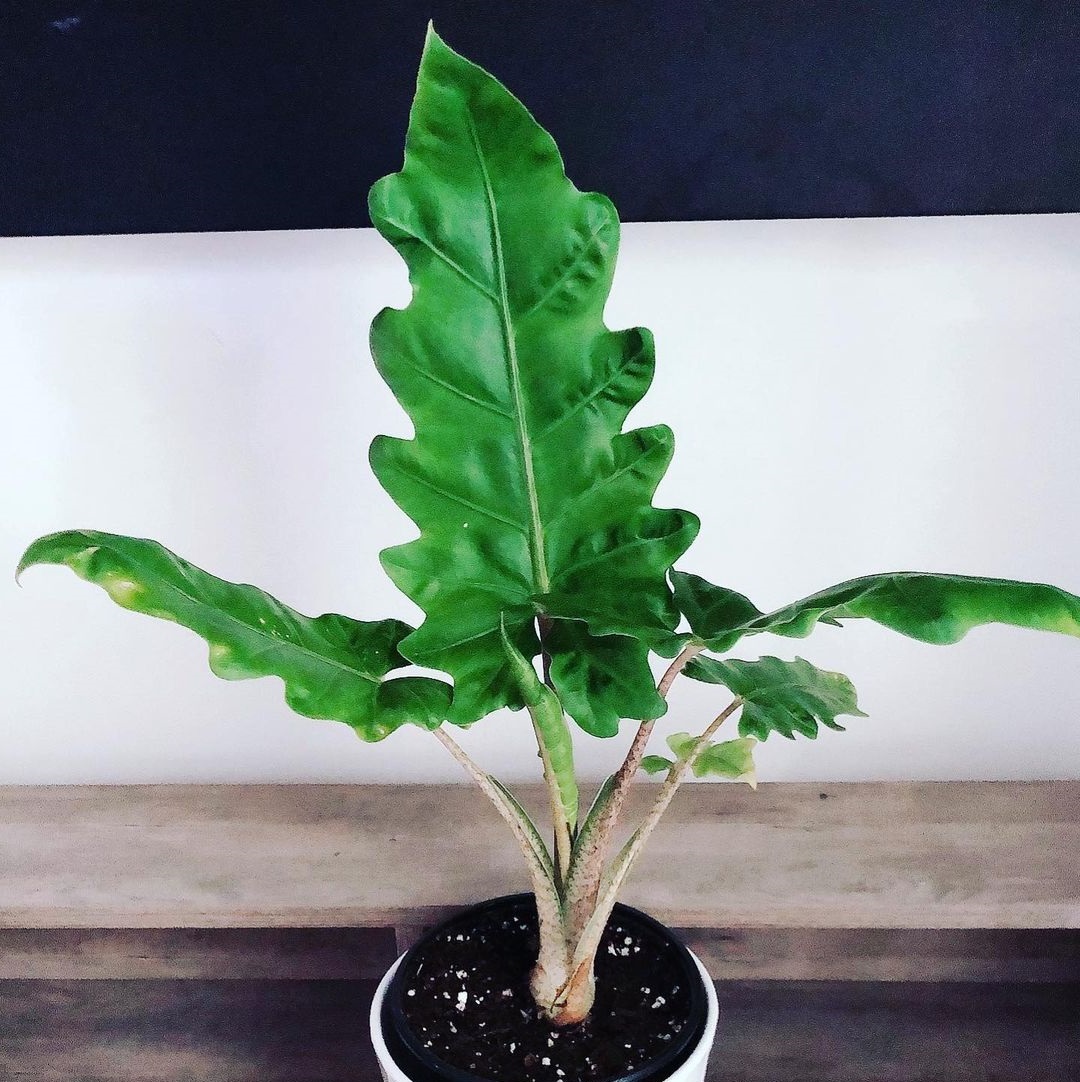
Moderately large at around 3 feet tall, this variety from New Guinea has an upright to leaning stem that can reach 5 feet long. It produces up to 6 leaves with arrowhead shapes and slightly serrated edges.
Alocasia boyceana
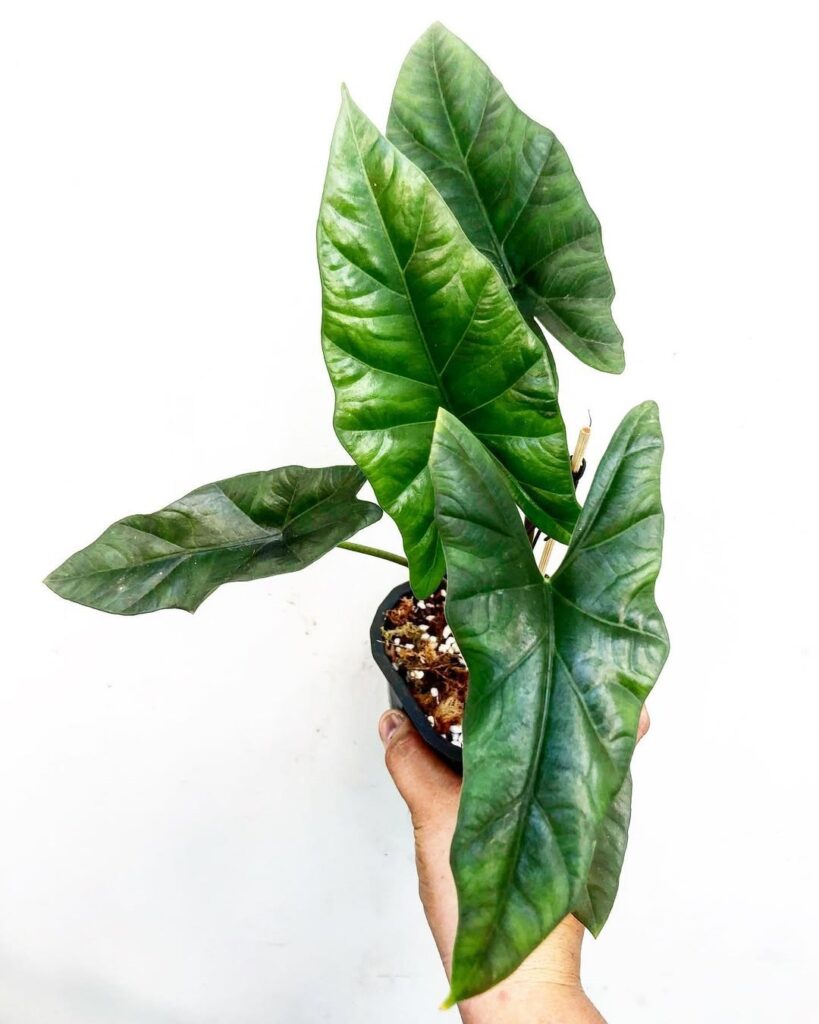
Another moderate-sized species reaching 2 feet tall with a 1 inch wide stem. It only has 1-3 narrowly arrowhead to slightly spearhead shaped leaves around 14 inches long. Found in Philippine rainforests, sometimes on limestone, at low-mid elevations.
Alocasia brancifolia

This 4 foot tall treelike plant has erect brown stems and 6 leaves with petioles up to 16 inches long. The petioles can be green, mottled, or strikingly striped with brown. The leaf blades are arrowhead-shaped. It’s native to the New Guinea and Maluku island forests, often in swampy areas.
Alocasia brisbanensis
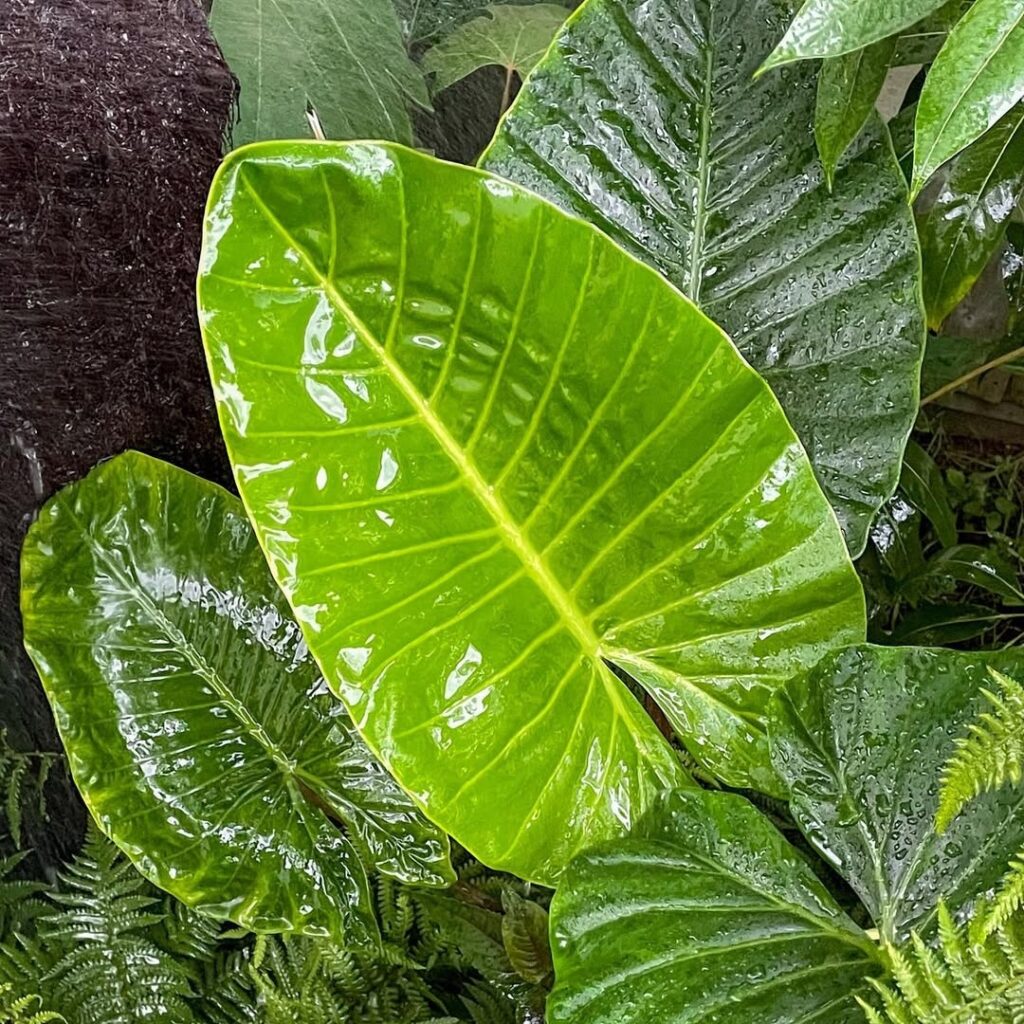
Now this is a massive herb! The decumbent to upright stem is about 5 inches wide, covered in old leaf bases. It produces several arrowhead to egg-shaped, pale to mid-green membranous leaves. You can find this giant in the rainforests and wet areas of Queensland and New South Wales in Australia.
Alocasia cadieri

Imported from central Vietnam in 1938, this vigorous variety has an upright, spreading habit. Its olive green leaves have dull yellowish veins.
Alocasia celebica
A tall plant reaching 5 feet, with a 1.5 inch wide rhizome covered in old leaf bases. It has just 2 egg-to-arrowhead shaped thickly leathery leaves about 14 inches long. The 14 inch petioles are mottled in a zigzag pattern. Found in northwest Sulawesi, Indonesia.
Alocasia chaii

This small but sturdy Bornean herb grows around 16 inches tall with a short upright to leaning stem. It has up to 4 leaves in the wild, more when cultivated. The broadly oval leaves are up to 16 inches long and 6-10 inches wide with a thickly leathery, almost succulent texture. They have pale green petioles speckled with deep red on the lower half.
Alocasia chienlii

Alocasia clypeolata

A small 12 inch tall herb with a short 2×1 inch stem and around 6 leaves. Petioles are 7 inches long. Leaves are slightly leathery, egg-shaped, 6×2.5 to 5×3 inches, darker along the veins. Also known as ‘Green Shield’ or ‘Green Cuprea’. Found in Philippines/Lesser Sundas on forest edges.
Alocasia ‘Corazon’

This cool Philippine variety was originally named after Maria Corazon “Cory” Aquino, a former president! It has wide, leathery, shiny pale green leaves and is reported to be extra hardy, surviving temps in the 40s°F. Some growers think it might actually be a distinct species from A. heterophylla based on the flower structures, but more research is needed.
Alocasia cucullata

One of the oldest known varieties, this small to medium-sized 3 foot tall clumping plant is native to parts of Asia like Thailand, China, and India. It has an upright, heavily branched base and many broadly egg to heart-shaped leaves 4-16×3-11 inches. Used medicinally and as a Buddhist good luck plant.
Alocasia cucullata ‘Banana Split’

Alocasia cucullata ‘Banana Split’ is a cultivar of Alocasia cucullata. It is characterized by yellow variegation which presents sectorally (when color reached the midvein) or regionally, with an uneven border that often extends into the center (color often stopping at lateral veins).
Alocasia cucullata ‘Crinkles’

Alocasia cucullata ‘Crinkles’ is a cultivar of Alocasia cucullata and is often sold as Alocasia triangularis, which is not an accepted name for this cultivar (i.e. it leads growers to believe it’s a distinct species due to the Latinized name). This cultivar is similar to Alocasia macrorrhizos ‘Shock Treatment’ in that both have suffered a similar mutation, leading to diamond-shaped leaves, ruffled/crinkled leaf edges, and a “cupped” leaf shape.
Alocasia cucullata ‘Moon Landing’

Alocasia cucullata ‘Moon Landing’ is a cultivar of Alocasia cucullata which is characterized by a pale center with an uneven green edge that is preferred to reach around most of the leaf and never extends into the center.
Alocasia cucullata ‘Yellow Tail’
Alocasia cucullata ‘Yellow Tail’ is a cultivar of Alocasia cucullata which is characterized by irregular pale yellowish variegation on the leaf edge, and a green center, opposite to the variegation of Alocasia cucullata ‘Moon Landing’.
Alocasia culionensis

A moderately robust 27.5 inch tall Philippine plant with 1 inch thick upright stems and several arrowhead to spearhead shaped 14×2 inch leaves. The 18 inch petioles are sheathed in the lower third. Found in lowland rainforests on damp shaded ground.
Alocasia cuprea

One of the most well-known tiny Alocasias at 31.5 inches tall on average. The decumbent 2.5 inch wide rhizome produces several hanging, glossy, leathery, egg-shaped 24×16 inch leaves that are bronze-green on top and deep purple below with colorless margins. The faintly mottled brown-green petioles are 27.5 inches long. Native to Borneo island at 3,300-4,900 foot elevations in rainforests on sandstone, limestone or ultramafic soils.
Alocasia decipiens

This variety has oblong, arrowhead-shaped leaves with rounded lobes that narrow to a point at the tip. The petioles are narrowly inserted about 2/3 of the way down the leaf length. It has twin long flower stalks and short spathes with round berries. Found in India, Bangladesh, Myanmar and the Andaman/Nicobar Islands, sometimes growing near limestone caves.
Alocasia devansayana

This New Guinean species has a short, tuberous rhizome with elongated, rounded petioles surrounded by a grayish sheath at the base. The slightly arched, copper-brown metallic petioles extend into the midrib. The leaves are shield-shaped, twice as long as wide, with flat, erect blades. Found at 2,600-5,700 feet elevation in forests around Mount Wilhelm, Papua New Guinea.
The Alocasia devansayana is synonymous with Colocasia devansayana. This species is found in New Guinea. It is observed to be growing between 800 m (2,625 ft) and 1,750 m (5,740 ft) elevation in the forests around Mount Wilhelm, south of Madang, Papua New Guinea.
Alocasia fallax

Leaves are broadly egg-shaped to rounded arrowhead shapes, measuring 12-20 inches by 9-12 inches with 7-9 pairs of major veins. Petioles range from 1-2 feet long.
Alocasia farisii

A small 10-21 inch tall Malaysian plant with an upright to leaning elongated rhizome. It has several thin, leathery arrowhead-to-spearhead or egg-to-arrow shaped leaves that are dark green along the veins and grayish-green elsewhere. Pale green petioles are sheathed 1/3-1/2 of the way down. Found as a lithophyte on limestone outcrops.
This species is found in Kelantan, Malaysia. It grows as a lithophyte in soil and humus pockets on limestone outcrops and boulders, rather occasionally as terrestrial, on seasonally dry lightly forested Karst formations, at 80-160 m (262-525 ft) elevations.
Alocasia flemingiana

A small 20 inch tall herb from Java with 1.4 inch wide rhizomes and several mid-green, thin, papery, arrow-to-egg shaped leaves with yellowish undersides. Petioles are green, sometimes mottled reddish-purple. Grows in teak forests, swamps, disturbed areas up to 3,300 feet.
This species is found in Java, Indonesia. It grows in the teak forest, swamp forest, disturbed forest, on volcanic soils, sometimes over limestone, from sea level to about 1,000 m (3,281 ft) altitudes.
Alocasia fornicata

This 2-3 foot tall rhizomatous/tuberous perennial has broad, many-veined leaves and slightly pink petioles. Leaves are wide triangular shapes and it spreads via horizontal stolons. Synonymous with Arum fornicatum. Found across South/Southeast Asia.
The Alocasia fornicata is synonymous with Arum fornicatum and Colocasia fornicata. It is found in Assam, Bangladesh, East Himalaya, India, Laos, Myanmar, Sri Lanka, Thailand, and Vietnam.
Alocasia ‘Frydek-Bullata’

A hybrid between A. micholitziana ‘Maxkowskii’ and A. sinuata created by Brian Williams. It has distinctively puckered, satiny leaves when newly emerged.
Alocasia gageana

Native to Myanmar, this variety has green undulating leaves with prominent, sunken midribs and veins. The slightly wavy leaf margins enhance its appearance. Often confused with A. macrorrhizos, but A. gageana has a semi-peltate leaf attachment and smaller, more oval leaves. It’s hardy down to 41°F. Variegated forms include ‘Aurea’ (yellow patches) and ‘Albo’ (white patches).
Variegated Alocasia gageana:


Alocasia ‘Golden Bone’


Alocasia ‘Golden Bone’ is a natural hybrid between Alocasia micholitziana ‘Maxkowskii’ and Alocasia cuprea.
Alocasia heterophylla

A small 16 inch tall Philippine species with a creeping 8 inch stem and 3-5 narrow arrowhead to spearhead shaped leaves up to 10.5 inches long. Some leaves are shallowly to deeply peltate.
Alocasia heterophylla ‘Green Veins’

Alocasia heterophylla ‘Green Veins’ is a cultivar of Alocasia heterophylla which is characterized by thick, leathery and glossy, arrowhead-shaped green leaves, with a marked contrast between the leaf surface and the midrib and veins.
Alocasia heterophylla ‘Green’

Alocasia heterophylla ‘Green’ is a cultivar of Alocasia heterophylla which is characterized by thick, leathery and matte, arrowhead-shaped green leaves.
Alocasia heterophylla ‘Silver Kris’

Alocasia heterophylla ‘Silver Kris’ is a cultivar of Alocasia heterophylla which is characterized by leathery and matte, arrowhead-shaped green leaves, with a specific silver upper side, and contrasting dark and embossed midrib and primary lateral veins and visible secondary veins.
Alocasia heterophylla ‘Silver’

Alocasia heterophylla ‘Silver’ is a cultivar of Alocasia heterophylla which is characterized by leathery and glossy, arrowhead-shaped green leaves, with a specific silver upper side, and contrasting dark midrib and primary lateral veins and visible secondary veins.
Alocasia hollrungii

Relatively small and sturdy with 1.5-4 inch wide decumbent rhizomes and about 6 variably-sized arrowhead leaves. The 35 inch petioles are green to bronze, sometimes pinkish-mottled. Native to Bismarck Archipelago, common in rainforests and plantations.
Alocasia hypoleuca

A giant 10 foot tall Thai species with a slender 6.5+ foot stem holding several erect 3×1.5 foot triangular light green leaves clustered at the top. Petioles are 2.5-3.3 feet long. Closely related to but more upright than A. macrorrhizos.
Alocasia indica

Historical Indian food and medicinal plant with heart-to-egg shaped 2-3 foot long leaves and distinct basal lobes separate from the petioles. Synonymous with A. metallica and A. variegata.
Alocasia infernalis

Small 22 inch tall Malaysian plant with a slender upright to decumbent stem and up to 12 spreading (juvenile) or erect (adult) leaves. The 8 inch bronze-green to purple petioles induce a snakeskin pattern in strong light. The egg-to-triangular 10 inch leaves are deep glossy purple on top.
Alocasia inornata

Vigorous 4 foot tall plant usually with 4-5 pale green, broad heart-to-arrowhead shaped leaves barely lobed at the vein tips. The densely dotted, violet-tipped petioles have a green streak on top. Found across Malaysia/Sumatra in various habitats up to 3,900 feet. Synonymous with A. nobilis.
Alocasia ‘Kalila’

Alocasia ‘Kalila’ is a hybrid between Alocasia ‘Bisma’ and Alocasia reginula ‘Black Velvet’. It was first hybridized by Bedy from Kalila Flower, Kalimantan. The same cross produced two other cultivars, Alocasia ‘Ulla’ and Alocasia ‘Katya’.
Alocasia ‘Katya’

Alocasia ‘Katya’ is a hybrid between Alocasia ‘Bisma’ and Alocasia reginula ‘Black Velvet’. It was first hybridized by Bedy from Kalila Flower, Kalimantan. The same cross produced two other cultivars, Alocasia ‘Kalila’ and Alocasia ‘Ulla’.
Alocasia kerinciensis

A small Indonesian herb to 5-6 inches tall with several stiffly textured, dull mid-green, peltate egg-shaped leaves 5-6×2.5-3.5 inches on 10 inch petioles sheathed near the base. Found at 4,900-6,600 feet elevation in montane forests.
Alocasia ‘Kulat’
‘Kulat’ means ‘mushroom’ in Malay and Tagalog languages. This tropical beauty thrives in humid climates with 60-70% humidity. Temps range from around 48°F up to 88°F during the day, with an annual rainfall of about 47 inches. There’s a rainy season October-May and a drier spell June-October.
Alocasia lancifolia

Moderately sturdy with 5-11 glossy mid-green lanceolate leaves to 20×5.5 inches on petioles to 14 inches long, sheathed over halfway. Native to scattered New Guinea lowland rainforests and swamps up to 2,000 feet.
Alocasia lauterbachiana

Upright 5 foot brown stems hold about 6 terminal leaves with 16 inch chocolate-mottled petioles sheathed 1/3-1/2. Leaves are narrowly spearhead-shaped, 12-16 inches long, deep bronze-green above and dark purple below with serrated margins. Native to northern New Guinea rainforests.
Variegated Alocasia lauterbachiana:


Alocasia ‘Lukiwan’

Alocasia ‘Lukiwan’ is a hybrid between Alocasia alba and Alocasia sinuata. It was first hybridized by Wawan at the Chong Lee Nursery in Malaysia, where he worked between 2001 and 2016.
Alocasia maquilingensis

A robust 3 foot tall Philippine species with densely fuzzy petioles up to 3 feet long on plants with broadly egg-to-arrowhead 22-35 inch leaves. Found at low-mid elevations in rainforests.
Alocasia melo

Alocasia melo grows to 25–35 cm tall, with an erect, short stem up to 3 cm wide and four leaves that overlap each other. Petioles are about 14–19 cm long, pale green, glabrous, smooth, and sheathed and sparingly burgundy-spotted in the lower fifth.
Its leaves are broadly egg-shaped to almost rounded, 18–25 cm long, 15 cm wide, wrinkled and blistered and somewhat bluish-green on the upper surface, smooth and pale greenish-white on the lower surface, leathery, and peltate.
Alocasia melo is synonymous with Alocasia rugosa and Alocasia ‘Rhino Skin’. This species is endemic to Sabah, Malaysian Borneo. This species joins a growing list of rare and endemic plants peculiar to the ultramafic substrate in Sabah. It grows on ultramafic rock, on the floor of tropical lowland rainforest, on thin soil along steep banks of fast-flowing streams, at 120-400 m (394-1,312 ft) above sea level. So, it requires high temperatures and humidity and protection from direct sunlight.
Alocasia micholitziana

Alocasia micholitziana is a moderately robust herb; its stem is about 4 cm (1.5 in) in diameter and is erect to decumbent. Four to seven leaves are present, without cataphylls. Petioles are 45 cm (18 in) long, sheathed in the lower quarter to third, and mottled brownish, reddish and/or purplish.
Approximately 40 cm long by 13 cm wide (16×5 in), and shallowly to shallowly peltate, the leaf blades are velvety matte deep green.
Alocasia micholitziana is synonymous with Alocasia ‘African Mask’, Alocasia ‘Green Velvet’, Alocasia ‘Green Goddess’, and Alocasia ‘Silver Vein’. This species is native to Luzon, Philippines. It grows in primary and secondary forests and roadside clearings at about 1,200-1,500 m (3,937-4,921 ft) altitudes. This species is common and widespread and presumably occurs over a somewhat wider altitudinal range than the limited available data indicate.
Alocasia micholitziana ‘Frydek’


Alocasia micholitziana ‘Frydek’ is a rare variegated cultivar of Alocasia micholitziana, characterized by white, mint, or yellow variegation, on top of the characteristic white veins and dark green velvet leaves of Alocasia micholitziana ‘Maxkowskii’.
Alocasia micholitziana ‘Maxkowskii’

Alocasia micholitziana ‘Maxkowskii’ is the most widely grown cultivar of Alocasia micholitziana, characterized by prominent white veins on a dark green velvet leaf surface.
Alocasia minuscula
Alocasia minuscula is a very small plant measuring 10-20 cm (4-8 in) in height. The stem is about 1 cm (1⁄5 in) wide, suberect, condensed, with roots along its length, and is covered with old leaf bases and marcescent cataphylls. It has several to nine leaves interspersed with papery membranous cataphylls. Petioles are 5-10 cm (2-4 in) long. The leaf blades are narrowly egg-shaped and roundly lanceolate, measuring 8-13 cm by 2-3 cm (3-5 in by 1 in), peltate, and leathery.
Alocasia minuscula is native to the Borneo island. It grows in the lowland peat swamp forest.
Alocasia monticola

Alocasia monticola is a moderately robust herb with erect or decumbent rhizomes about 30 cm (12 in) long and 3.5 cm (1.5 in) wide. It has six leaves with 45 cm (18 in) long petioles that are green and sometimes mottled dark red. There is a distinct spearhead shape (sometimes arrowhead-shaped) to the leaf blades, and they are held horizontally.
This species is native to New Guinea. It grows in lower montane rainforest undergrowth, usually in damp sites.

In addition to its massive size of 1.5 m (5 ft) and thickness, Alocasia navicularis is evergreen and contains milky latex. Leaves are several together, clustered at the tips of larger plants’ stems. Petioles can reach 1.5 meters (5 ft) long. Leaf blades are about 130 by 120 cm (51 by 47 in) and are heart-shaped and peltate.
Alocasia navicularis is synonymous with Colocasia navicularis. This species is native to Assam, Bangladesh, China (South-Central), India, Laos, Myanmar, Nepal, Thailand, and Vietnam. It grows in moist evergreen lower-montane forests and sometimes on limestone.
Alocasia nebula

This 8-12 inch tall Bornean species has a 1 inch thick stem and around 6 leaves. The 6 inch petioles are dull pale green speckled with deep purple dots. Leaves are egg to arrowhead shaped, leathery, with a matte gray-green upper surface and dark reddish-purple undersides. It grows on limestone rainforest floors at low elevations. Synonymous with A. guttata var. imperialis.
Alocasia nicolsonii

A robust New Guinean herb with a 3 inch wide decumbent rhizome bearing up to 12 leaves. The 35 inch petioles have scattered glands on top. Leaves are arrowhead to egg-shaped, dull to slightly glossy green on top and paler underneath, sometimes with reddish-purple tones. Found in damp montane rainforests at 5,600-8,900 foot elevations.
Alocasia nycteris

About 5 feet tall with 1 inch wide erect or leaning stems and 3 foot long blackish-green streaked petioles sheathed 1/4 of the way. Leaves are 14.5 inch spearhead to arrowhead shapes of a glossy dark green color. Native to Philippine forests and disturbed areas. Synonymous with A. ‘Batwing’.
Alocasia odora

Widespread across South/Southeast Asia, this species has several synonyms like A. commutata and A. tonkinensis.
Alocasia odora ‘Blue’
Alocasia odora ‘Blue’ is a cultivar of Alocasia odora originating from Yunnan, China. Its name comes from the bluish color observed in the petioles and peduncles, which can sometimes also extend into the main veins of the leaf. The best color shows when the plant is grown in shade. The leaves are thinner and more papery in feel than those of the Alocasia odora.
Alocasia odora ‘Indian’

Alocasia odora ‘Indian’ is a cultivar of Alocasia odora. This cultivar resembles Alocasia cucullata, however, grows much larger, is a lighter shade of green overall, and produces many more blooms than Alocasia cucullata does.
Alocasia odora ‘Okinawa Silver’

The only variegated cultivar of Alocasia odora is ‘Okinawa Silver’. Compared to Alocasia odora, white-variegated Alocasia macrorrhizos, or white-variegated Alocasia gageana, it grows much smaller in size. In Alan Galloway’s report, the largest specimen measured 1 m (3 ft) high.
Although it’s hard to identify, Alocasia odora ‘Okinawa Silver’ has an asymmetry between the white and green sectors that is not seen in other cultivars of Alocasia odora, Alocasia gageana, or Alocasia macrorrhizos.
Alocasia pangeran

A 24 inch tall endemic to Sabah, Borneo found only at Madai Caves growing on limestone outcrops in lowland forests around 1,300 feet elevation. It has 4 variably arrowhead to spearhead shaped 8-14 inch dark green leaves with 24 inch smooth, dark green petioles.
Alocasia ‘Pasappa’
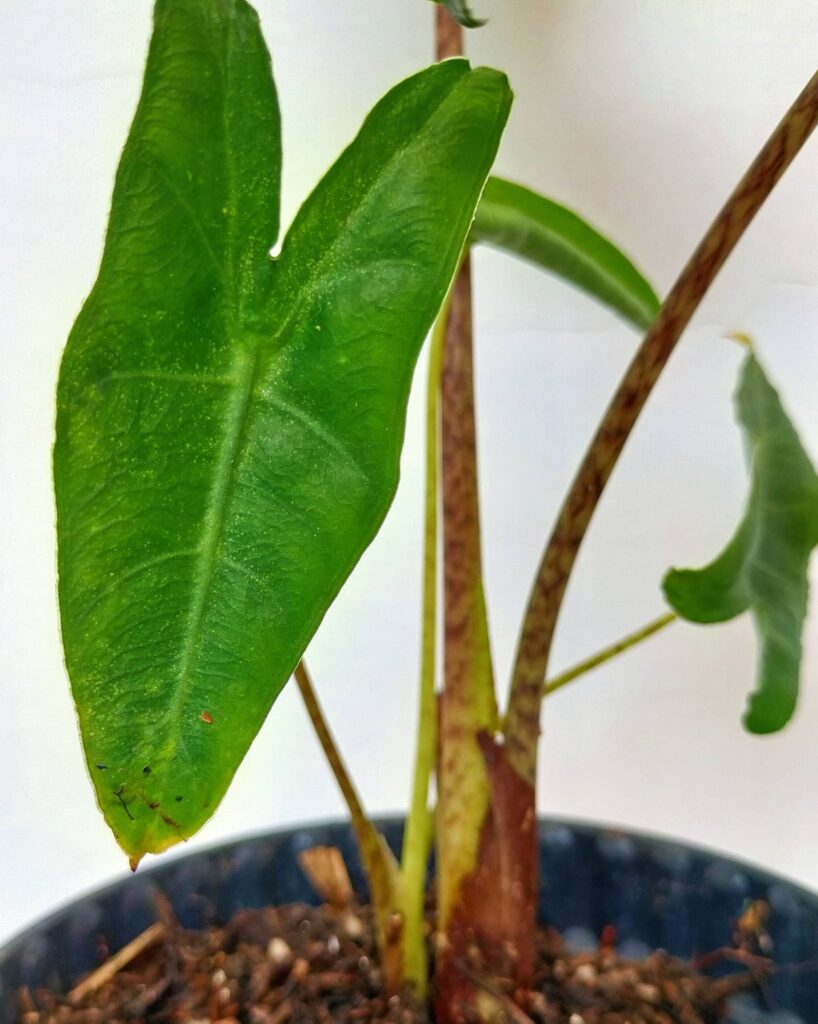
Taking its name from the West Sulawesi town where it originated, ‘Pasappa’ is an Indonesian native. Not much is known about this variety yet!
Alocasia peltata

Only about 12 inches tall, this Bornean endemic has slender sprawling 1 inch long internodes with a few glossy green or purple 5-11×1-4 inch narrowly elliptic peltate leaves alternating with papery cataphylls along the stem. Short 6 inch petioles. Found at 3,900 foot elevations.
Alocasia peltata ‘Silver Grey’

Alocasia peltata ‘Silver Grey’ is a cultivar of Alocasia peltata with silvery grey leaves.
Alocasia perakensis

A semi-erect 29.5 inch Malaysian plant with creeping 1 inch wide elongated stems holding several dark to gray-green, egg to elliptic, leathery, peltate 16 inch leaves along the purplish-brown 16 inch petioles. Grows in montane forests around 3,600-5,000 feet.
Alocasia perakensis ‘Silver Giant’

Alocasia perakensis ‘Silver Giant’ is a larger leafed silvery-green cultivar of Alocasia perakensis introduced in 2021/2022 by Silver Krome.
Alocasia portei

This massive 20 foot tall Philippine tree-like species has a 16 inch wide base with tessellating bark. The pinnately divided, ruffled 5 foot arrowhead leaves have 5 foot long yellowish to chocolate-mottled petioles. Found in low-mid elevation secondary forests. Also known as the ‘Malaysian Monster’.
Alocasia ‘Prince of Curup’

Despite the royal name, this thick, leathery-leafed variety actually hails from the humble town of Curup in Sumatra. Unlike other Sumatran species, it’s not a lithophyte (rock-dweller). The embossed veins between the leaf’s secondary veins are really unique! Some think it resembles A. longiloba ‘Watsoniana’ but more research is needed. Be careful though – it has extremely high levels of calcium oxalate crystals.
Alocasia princeps

A robust 2.6-6 foot Bornean herb with about 4 leathery, glossy dark green leaves that are spearhead to triangular arrowhead shaped and up to 21.5 inches long. The 5 foot suberect petioles are brownish-green with purple dots/lines. Common in rainforests on various soils up to 3,900 feet.
Alocasia princeps ‘Candy Sticks’

Alocasia princeps ‘Candy Sticks’ is a cultivar of Alocasia princeps.
Alocasia princeps ‘Purple Cloak’

Alocasia princeps ‘Purple Cloak’ is a cultivar of Alocasia princeps.
Alocasia principiculus

A small 10-12 inch lithophytic Bornean plant found on limestone at sea level to 2,000 feet. It has several dull to slightly glossy, gray-green arrowhead to narrowly triangular spearhead shaped leaves around 10 inches long on 8-12 inch gray-green to purple-brown petioles.
Alocasia ‘Pseudo Sanderiana’

An aroid with deep brownish-green arrowhead leaves featuring purple undersides and more relaxed silver veining compared to A. sanderiana. The leaf margins are less wavy.
Alocasia puber

A massive robust species reaching 5 feet tall with a 4 inch thick stem and several leaves. The hairy petioles are up to 5 feet long and green to dark red. The usually arrowhead-shaped blades grow to an immense 32×28 inches. Found across Malaysia/Sumatra in open swampy areas up to 3,300 feet elevation.
Variegated Alocasia puber:


Alocasia ramosii

This small Philippines native only grows around 16 inches tall. It has 2-several arrowhead or spearhead-shaped membranous leaves clustered together, with petioles up to 10 inches long. The leaves are pale green and papery, with 4-5 major veins per side. Endemic to the islands of Luzon, Negros and Panay.
Alocasia reginae
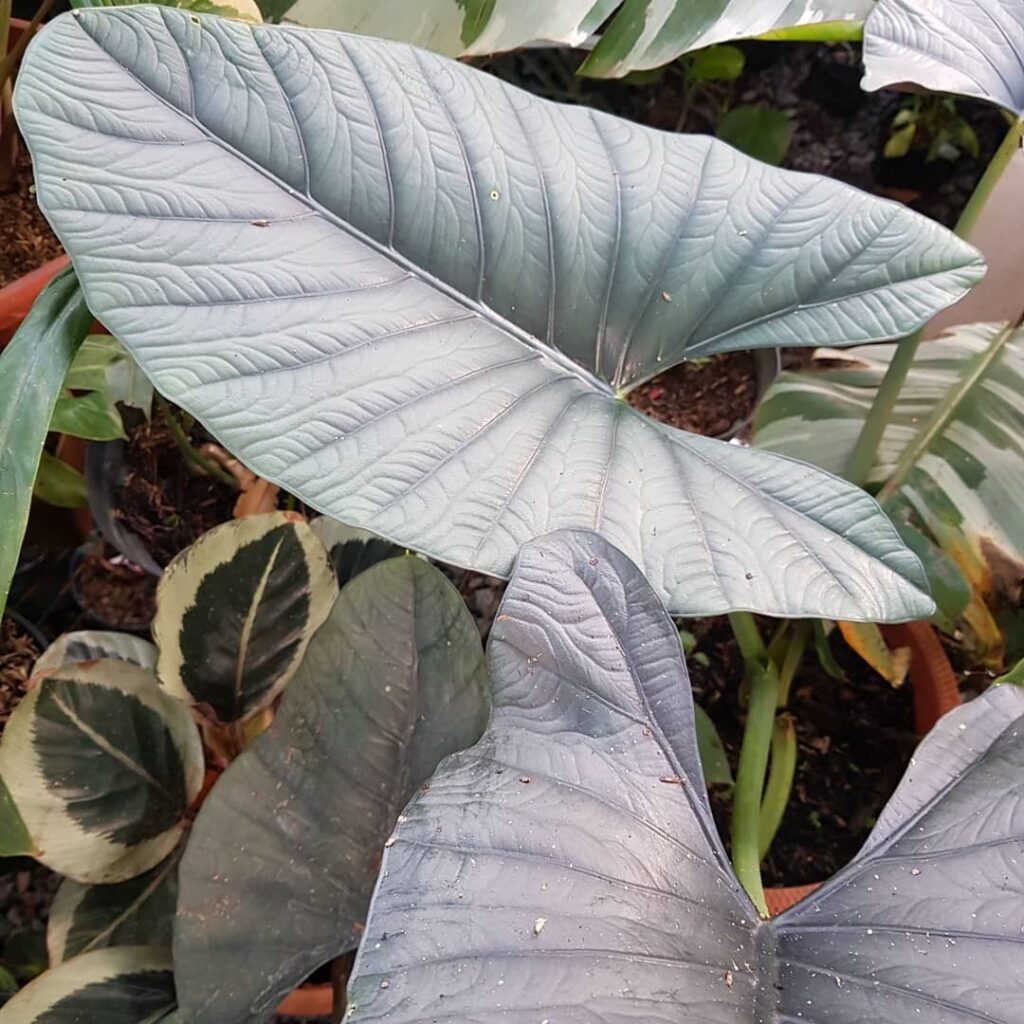
A tiny 8-12 inch Bornean species with 2-4 thickly leathery, dark green leaves that sometimes blush purple underneath. The broadly egg-to-arrowhead shaped leaves have pointed tips on stumpy 4-10 inch petioles. Only found in a few locations in Sarawak and Central Kalimantan.
Alocasia reginae ‘Elaine’

This cultivar of the tiny Bornean A. reginae was named after famous Florida collector Elaine Speers. ‘Elaine’ grows slower and stays more compact than ‘Miri’. It has lighter bluish coloring on the leaf tops and fainter reddish undersides compared to the darker tones of ‘Miri’. This is the most widespread A. reginae cultivar in collections.
Alocasia reginae ‘Miri’
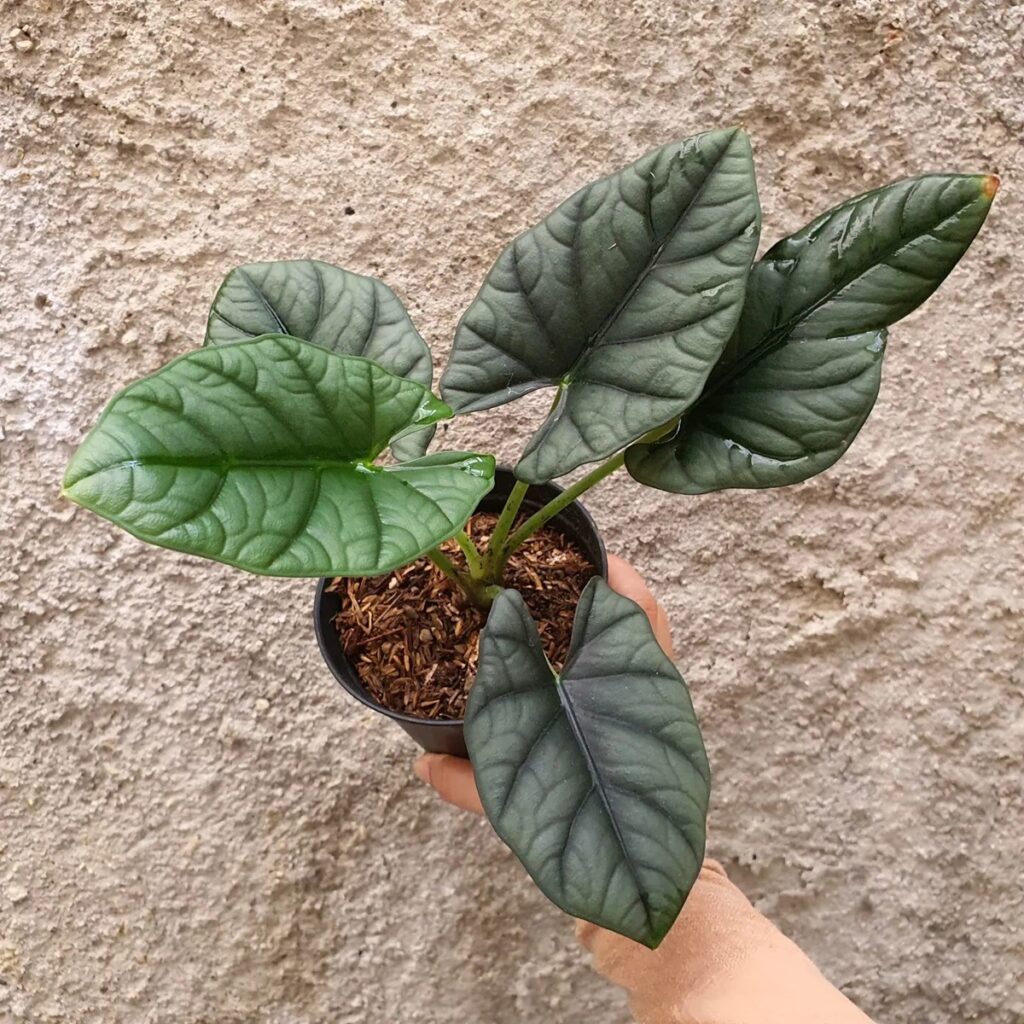
The ‘Miri’ cultivar is a vigorous grower of A. reginae that usually gets larger than ‘Elaine’. Its leaves have much darker red undersides and the tops are a deeper green with just a bluish tinge, as opposed to the lighter blue tones of ‘Elaine’. Not as commonly cultivated as ‘Elaine’. ‘Miri’ refers to the city in northern Malaysian Borneo.
Alocasia reginula
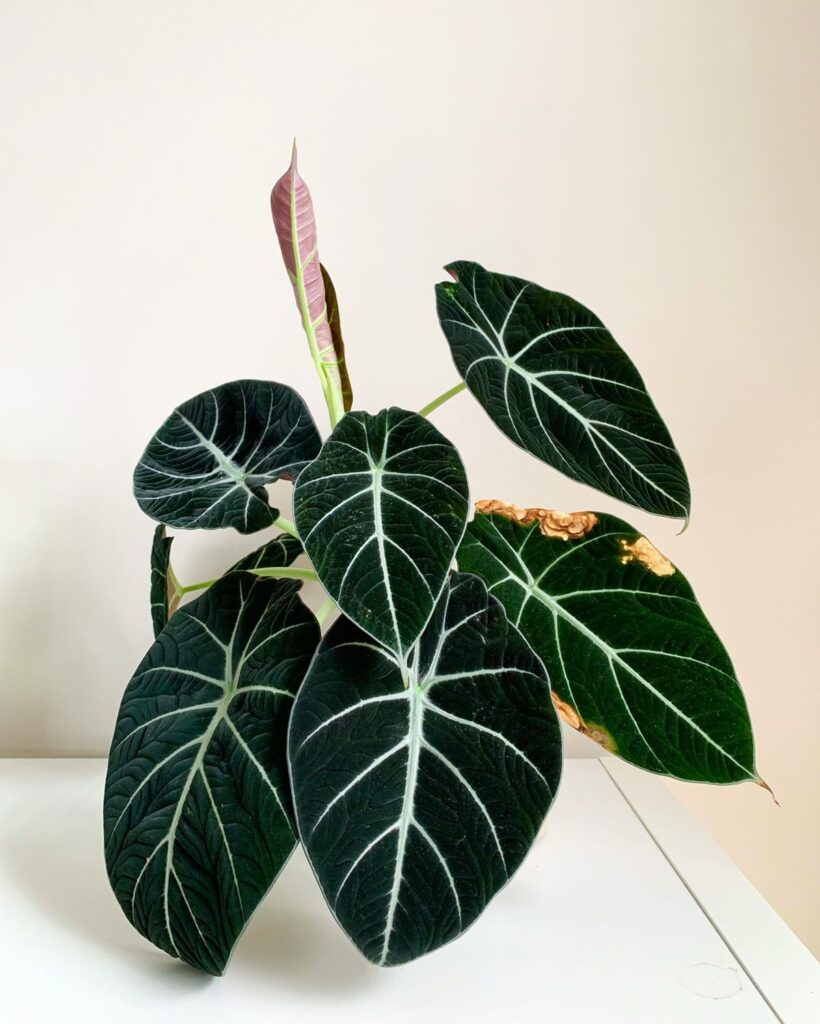
Believed to originate from Borneo, this petite 10-inch plant produces several almost circular, leathery black-green leaves around 6-9 inches wide and wide. They have pale undersides and are nearly peltate (shield-shaped).
Alocasia reginula ‘Black Ninja’
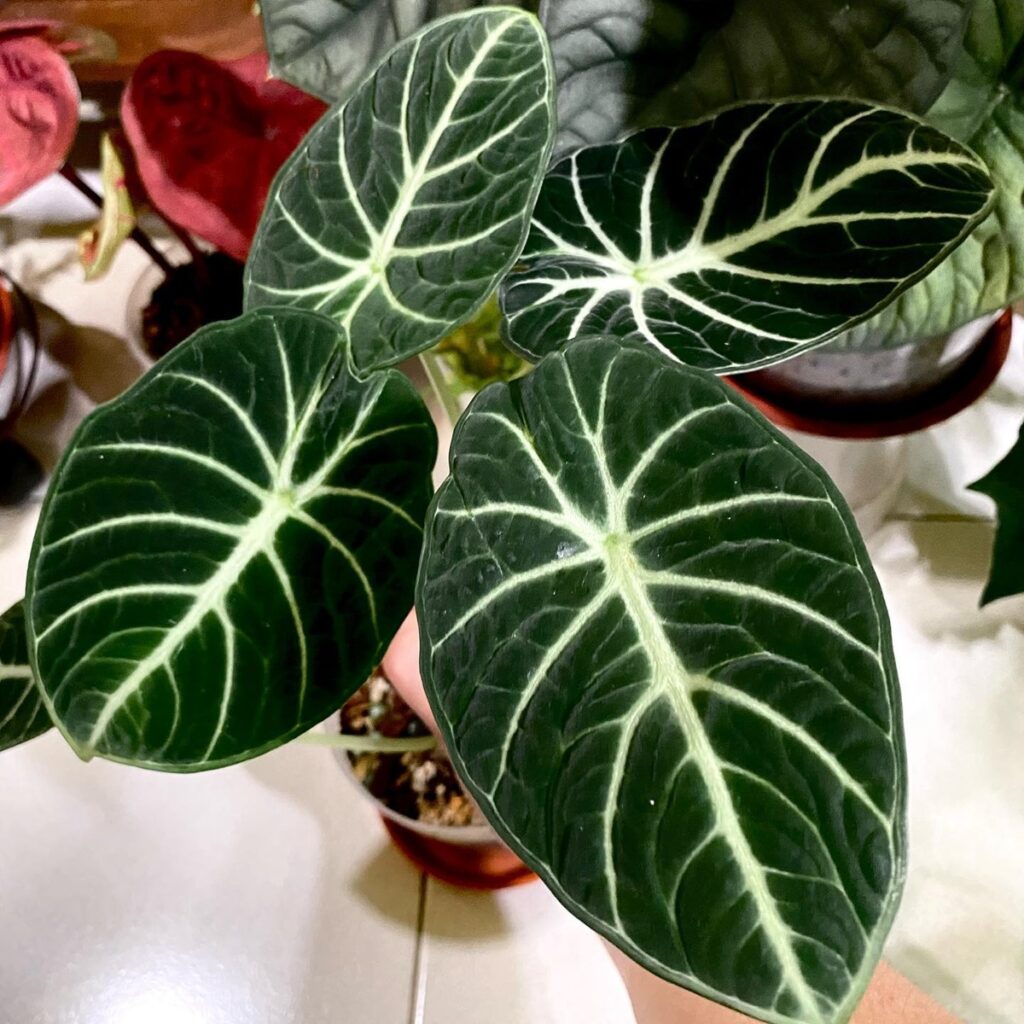
Introduced around 2020, this cultivar is almost identical to A. reginula ‘Black Velvet’ except for having characteristic double marginal veins and thicker, more embossed leaves. Some think it’s just a minor mutation that becomes indistinguishable from ‘Black Velvet’ as it matures. Also sold as ‘Black Velvet Ninja’.
Alocasia reginula ‘Black Velvet’
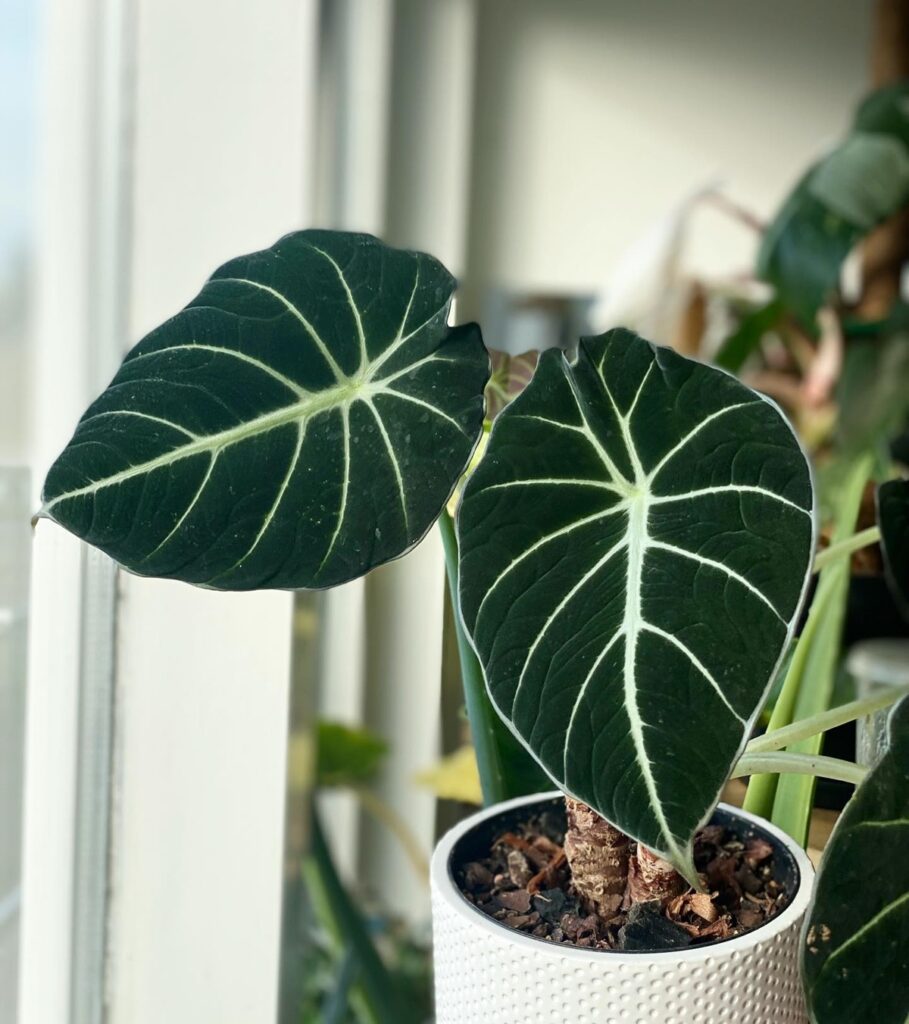
The quintessential jet-black velvet-leafed cultivar that has become synonymous with the A. reginula species itself. It was originally discovered in Borneo in the early 1990s by a Japanese collector, who provided the plant that was tissue cultured into this cultivar by Agristarts.
Alocasia reginula ‘Silver Velvet’
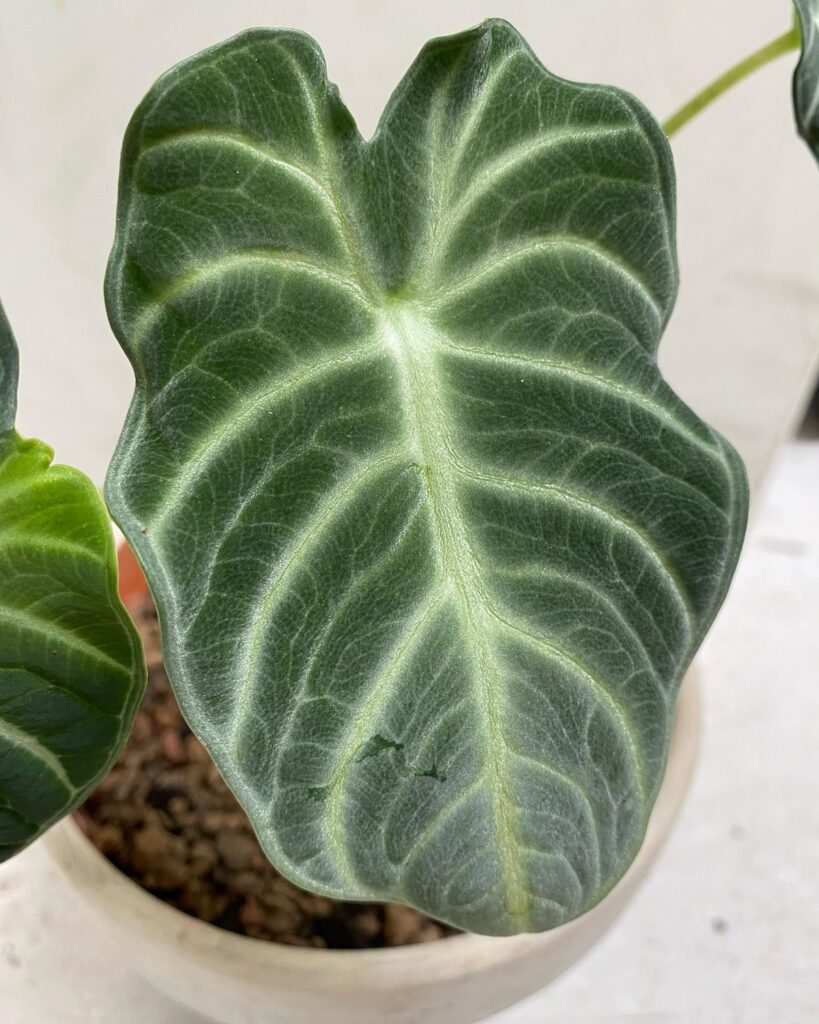
An extremely rare silver-tinted cultivar that looks almost identical to ‘Black Velvet’ except for the characteristic light silver adaxial (upper) leaf surface, similar to A. longiloba ‘Lowii’. Otherwise, shared growth habits and leaf morphology with ‘Black Velvet’.
Alocasia reverse
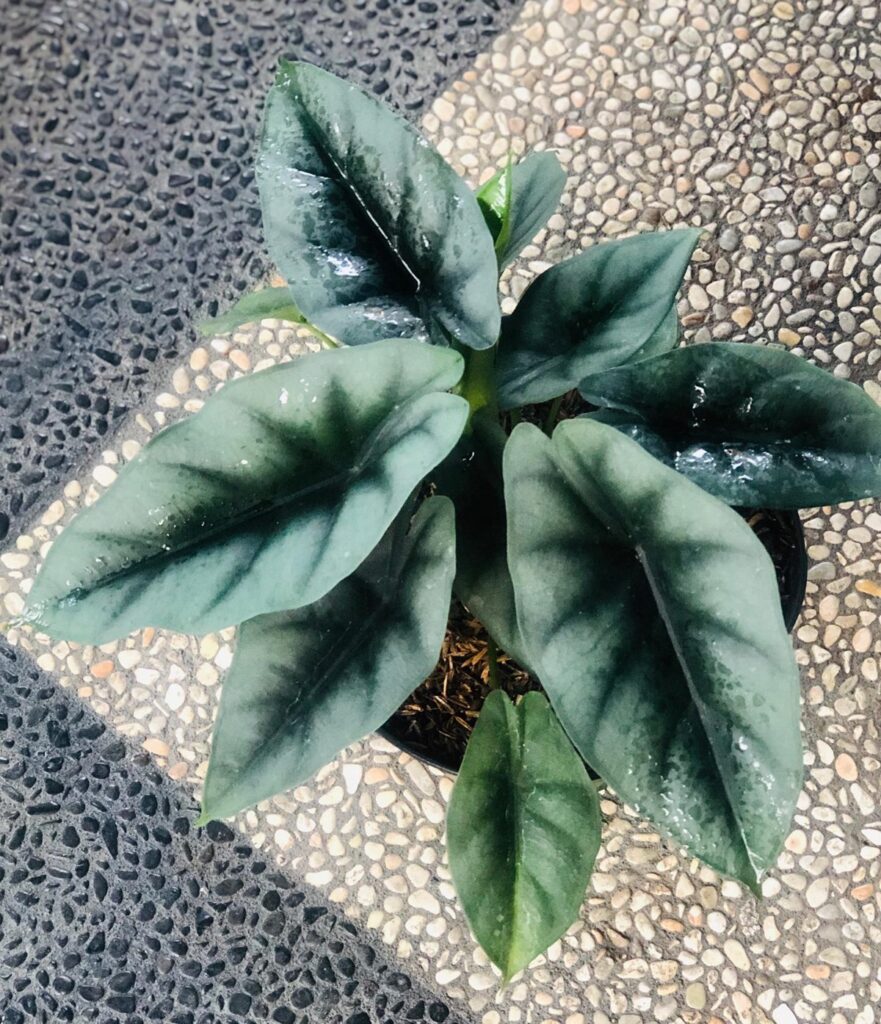
From the Padawan district of Sarawak, this small 14 inch herb is unique in having a mix of peltate and non-peltate leaves that are glossy dark green along the veins and gray-green elsewhere. The slender 4-12 inch petioles emerge from a short 1 inch thick rhizome.
Alocasia ridleyi
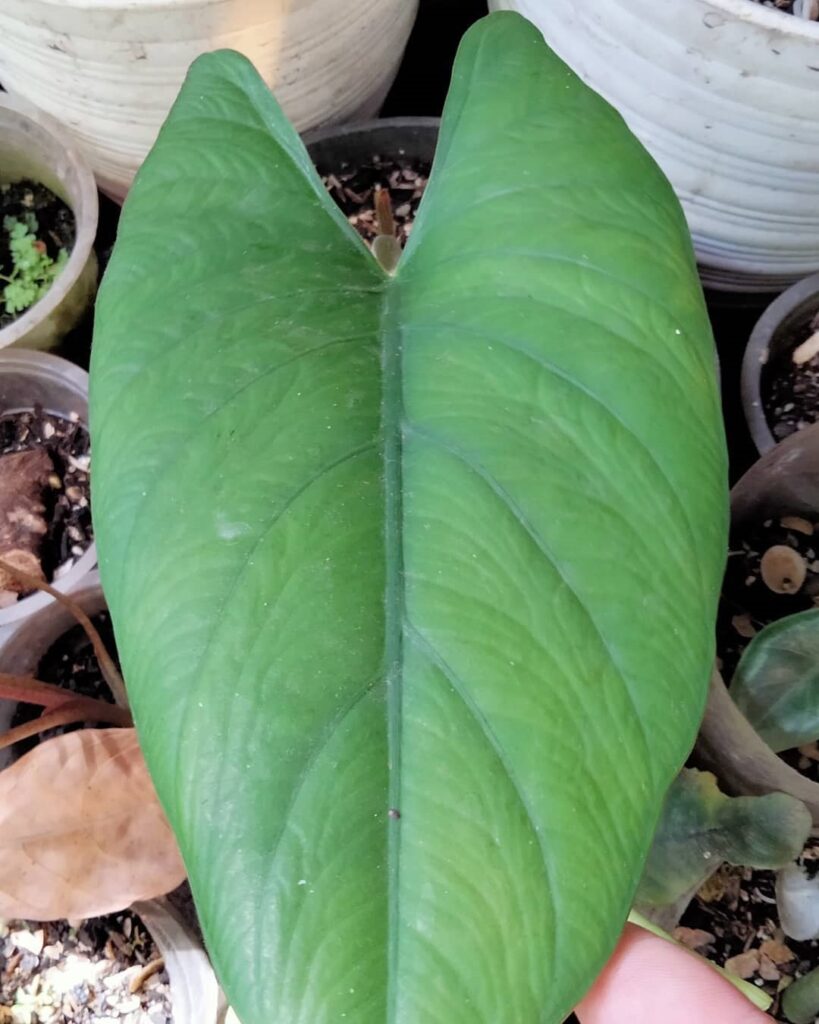
A small to large Bornean species found only in SW Sarawak. It ranges from 18 inches to over 3 feet tall on a 1-2.5 inch thick rhizome. The stiffly leathery, narrowly arrowhead leaves are 6-20 inches long and shiny dark green when young before dulling. Petioles can reach up to 35 inches.
Alocasia rivularis
This 28 inch Vietnamese plant has thin, lance-shaped leaves up to 9.5 inches long that are asymmetrically attached almost like a shield. Dark green on top and pale underneath. Stems are slender at 1 inch wide and can have up to 11 leaves clustered together. Found growing by rivers.
Alocasia robusta
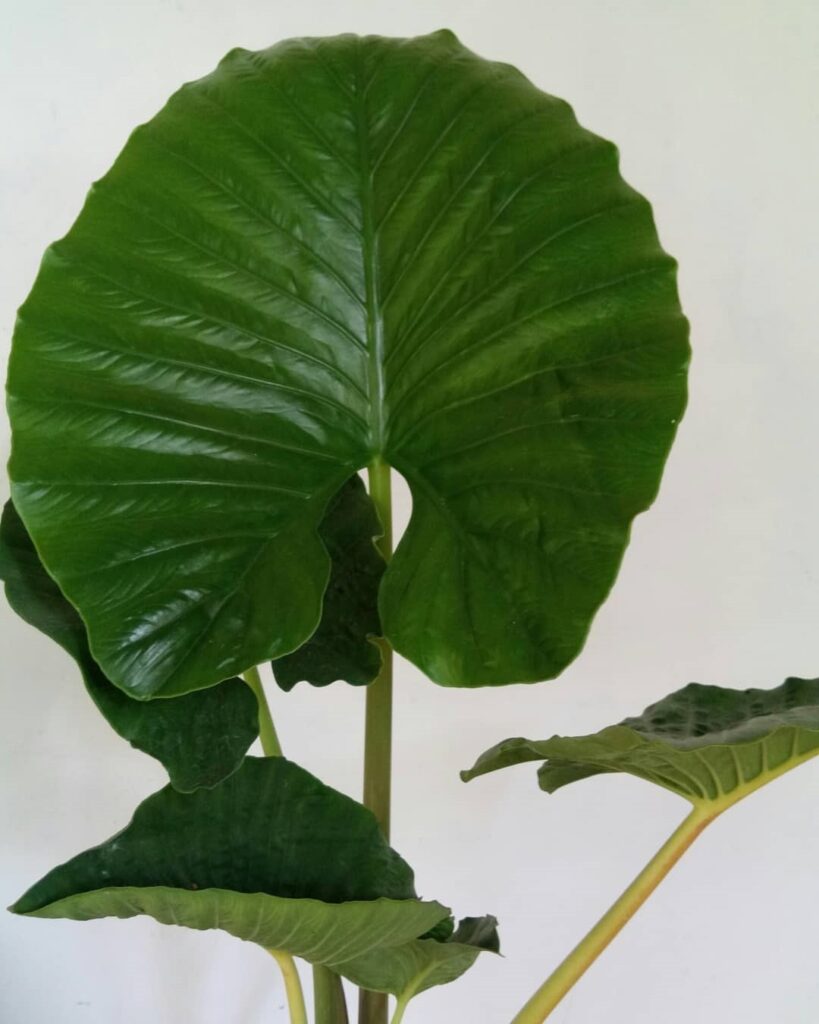
Appropriately named, this giant Bornean tree-like plant can reach 20 feet tall! Its huge 5-13 foot arrowhead leaves emerge from pale pink-brown petioles up to 11.5 feet long. The stems can be over 1 foot wide at the base. An absolute monster of the Alocasia world!
Alocasia salarkhanii
This Bangladeshi species is closely related to A. fornicata but can be told apart by its deep purple peduncle (flower stalk), long elliptic leaf shape, less than 4 flower clusters, and equal widths of the appendix base and male flower zone. It’s a small to moderately-sized plant with glossy dark green, arrowhead leaves up to 21 inches long.
Alocasia sanderiana
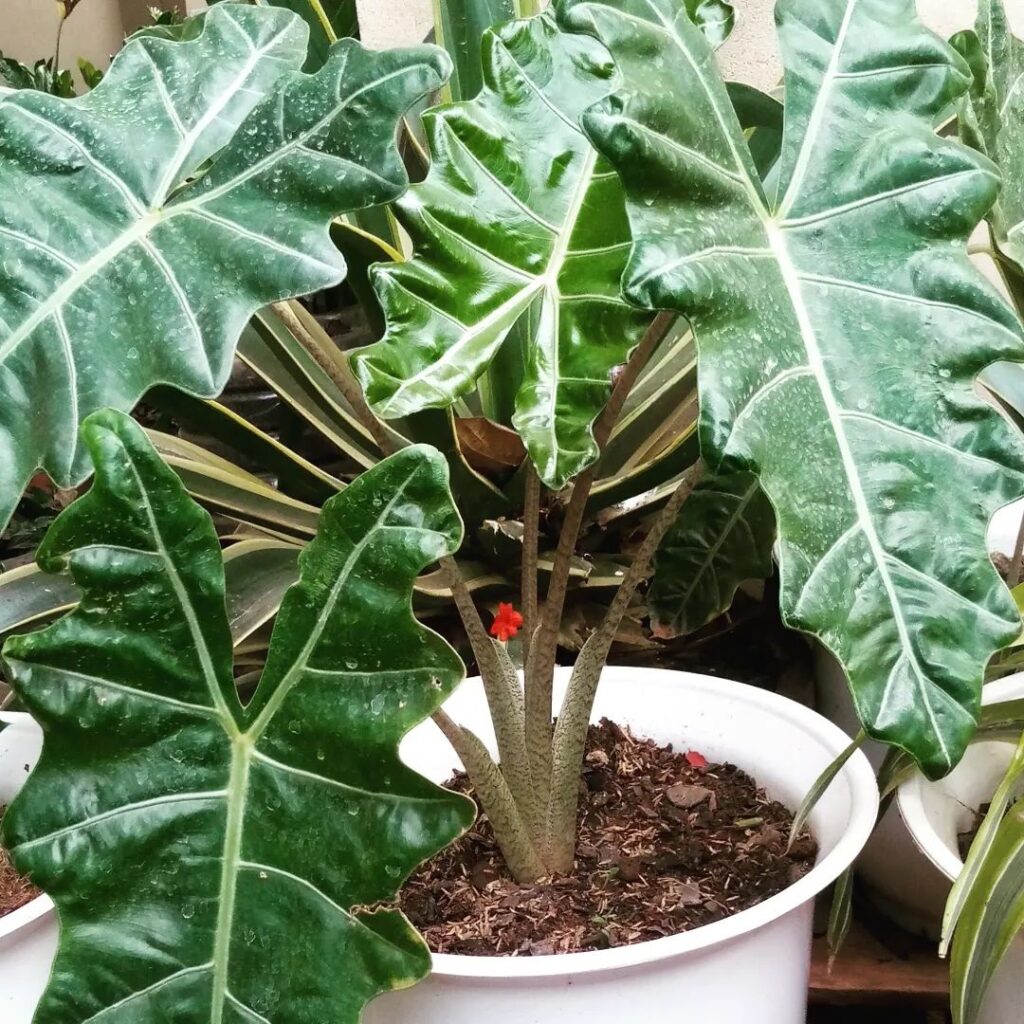
Native to the Philippine island of Mindanao, this moderately robust 2-foot tall plant is the original species that the hybrid ‘Amazonica’ was created from. A. sanderiana has fewer major veins (3-4) than ‘Amazonica’ and its wavy leaf margins are less deeply lobed. The leaves can be up to 16 inches long and are a deep glossy green on top, purple underneath.
Alocasia sarawakensis
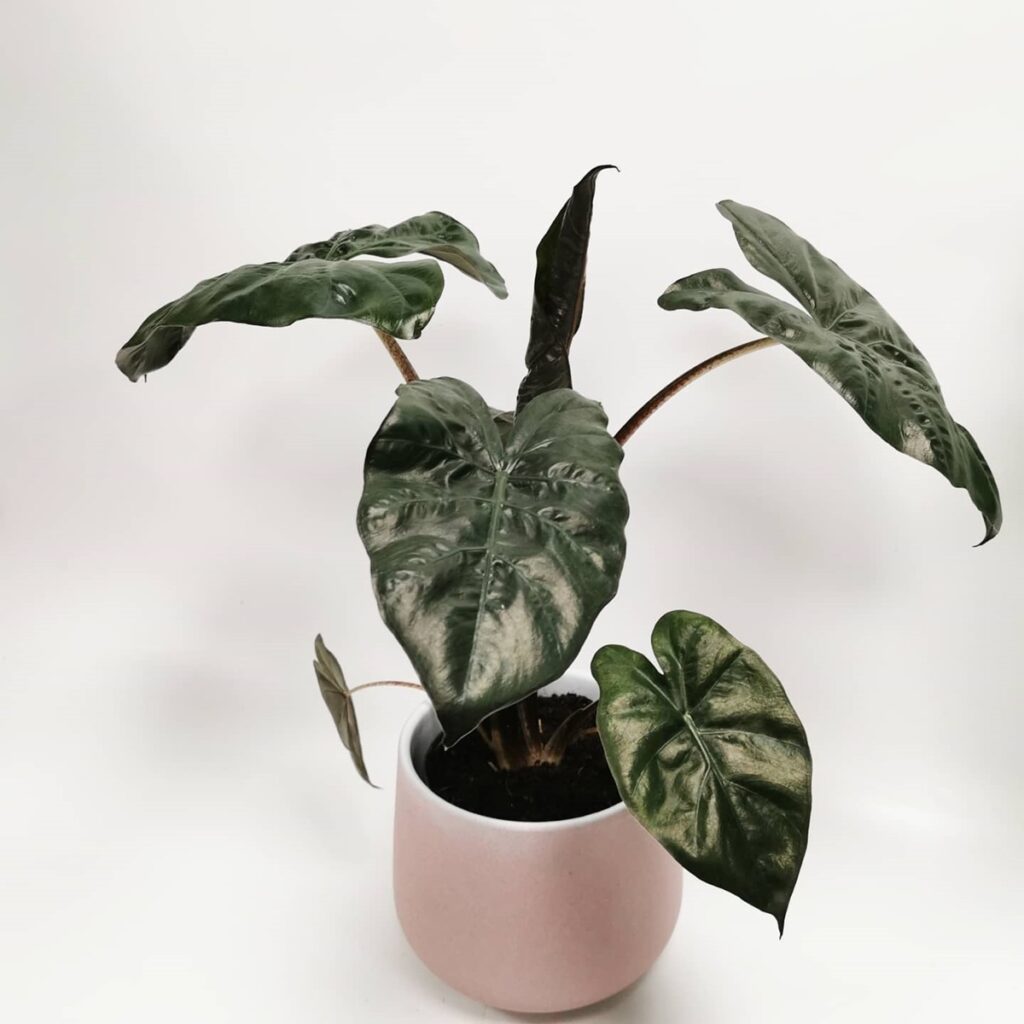
Massive and tree-like, this Bornean behemoth can reach 6 feet tall! Its huge, arrowhead-shaped leaves span up to 32 inches long by 24 inches wide and are a herbaceous green color. The thick petioles are up to 55 inches long and the spathe (flower covering) is white with purple stripes. An absolute monster!
Alocasia ‘Sarian’
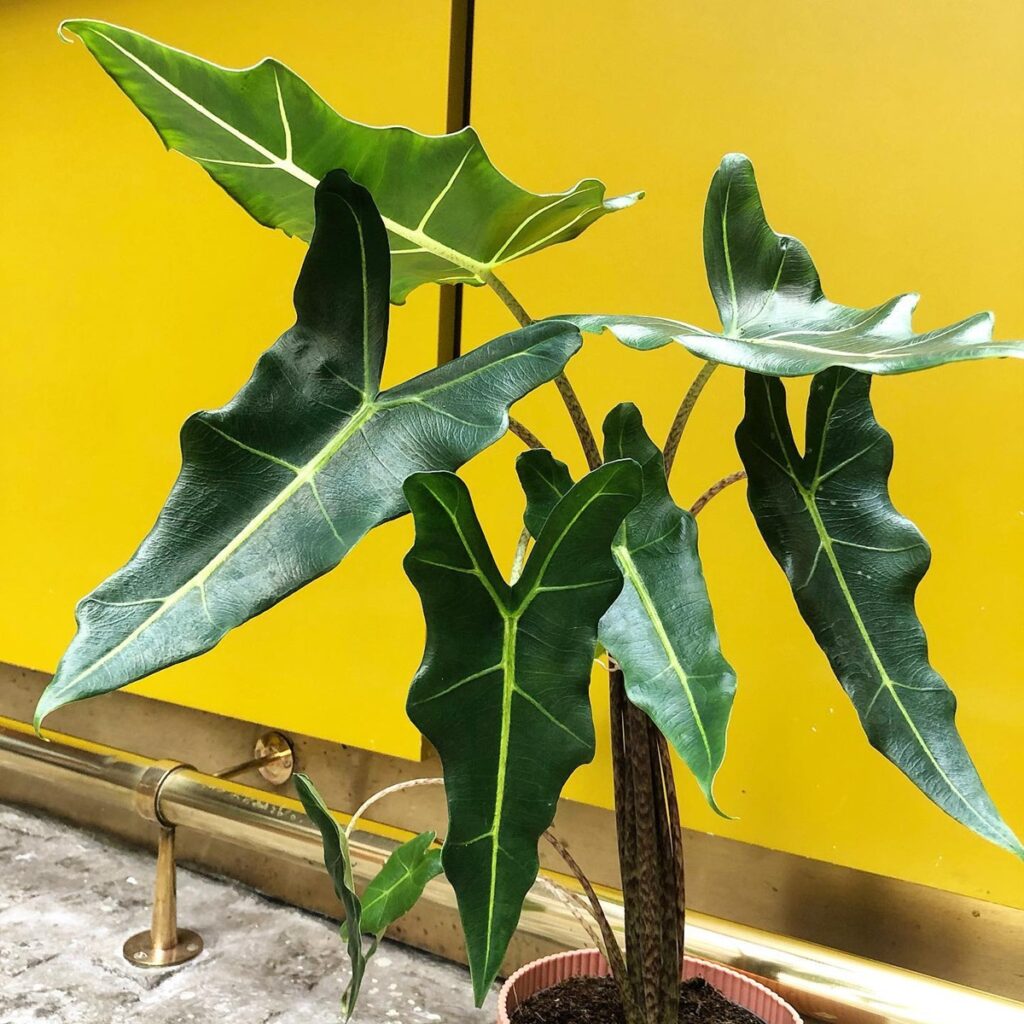
This undescribed species hails from Ilocos Norte province in northern Luzon, Philippines. It was named after the late Zacarias ‘Zac’ Sarian, a Filipino agriculture writer who first collected it in the 1980s while surveying local Aglaonema plants. Some thought it was a hybrid of A. zebrina and A. micholitziana, but Zac clarified it’s a widespread native species.
At elevations around 2,800 feet, A. ‘Sarian’ and A. micholitziana grow side-by-side but stay distinct. ‘Sarian’ has thinner, deeply wavy leaves compared to micholitziana’s velvety, shallowly wavy ones. Genetic studies are ongoing to determine its exact relationship to other Philippine alocasias.
Alocasia scabriuscula
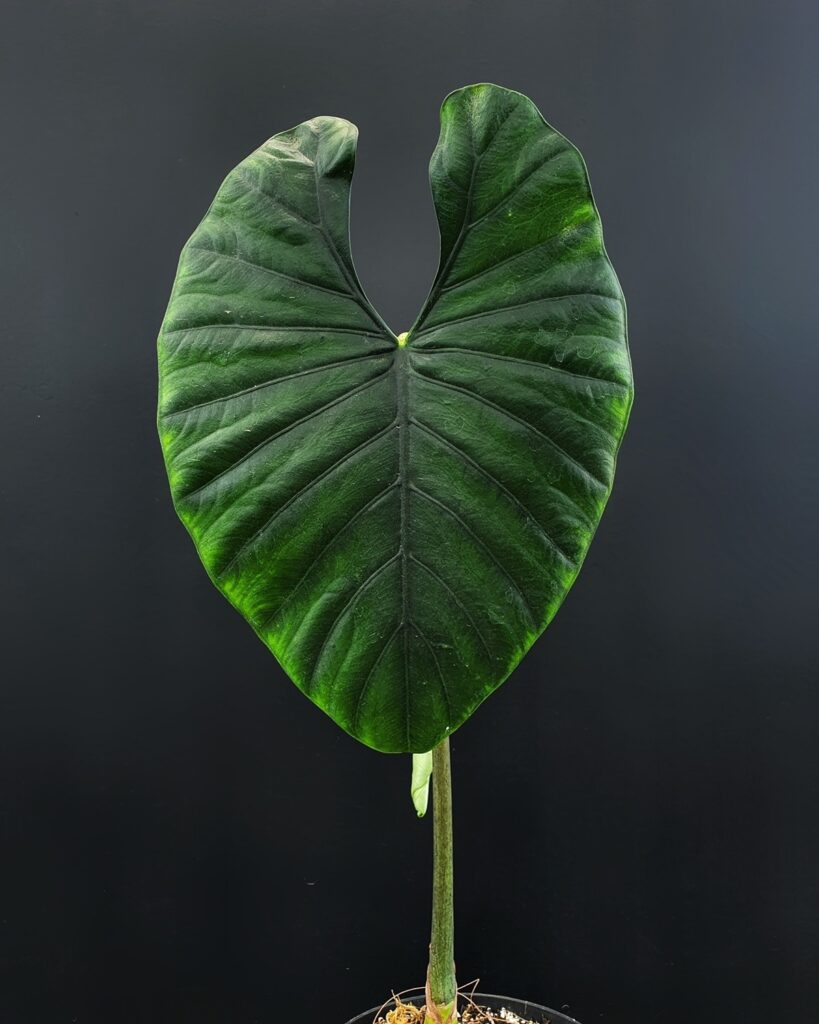
A robust 2-4 foot tall Bornean species with large 16-34 inch long arrowhead to broadly egg-shaped leaves that can be various shades of green or flushed rich purple underneath. The thick, leathery to succulent textured leaves have well-defined veins on both sides. Petioles range from 16-39 inches.
Alocasia scalprum

Tiny little endemic from the island of Samar in the Philippines with several narrow, slightly curved lance-shaped leaves only 2-5 inches wide but up to 10 inches long. The yellowish-green petioles are around 4 inches. The miniature posterior lobes are just 0.5-1 inch long triangular flaps!
Alocasia ‘Serendipity’
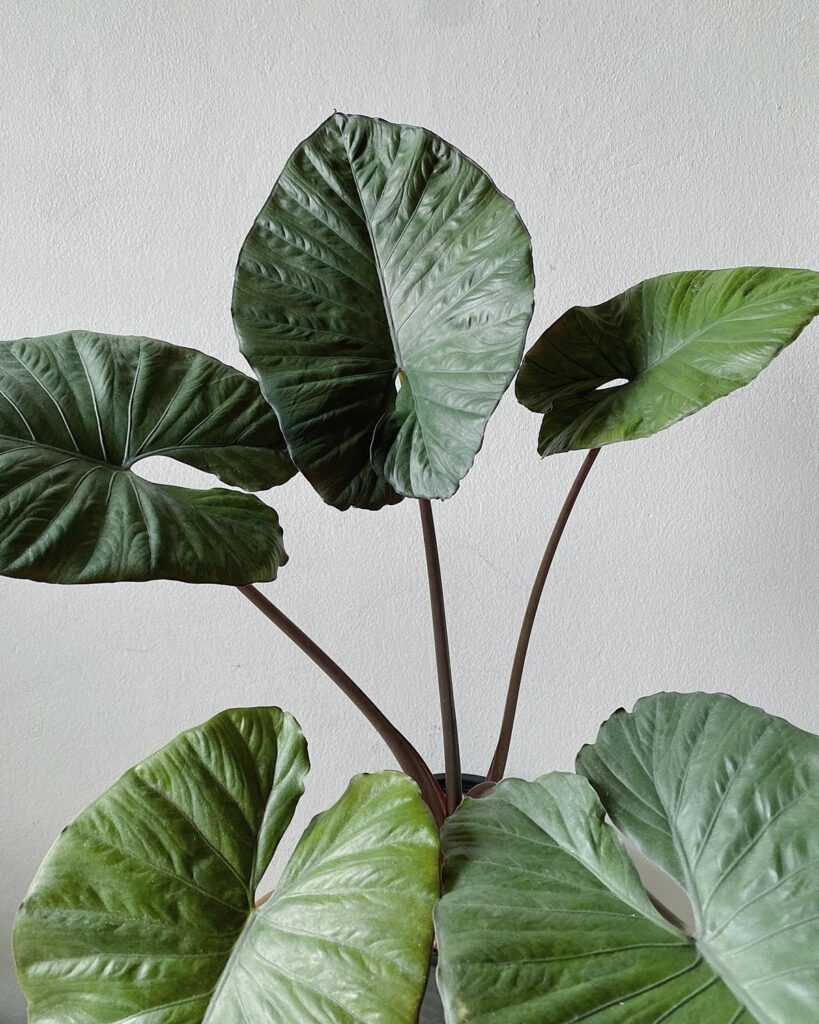
Plant breeder LariAnn Garner stumbled upon (how serendipitous!) this unlabeled beauty at a nursery, initially thinking it resembled A. sarawakensis. The all-dark reddish-bronze leaves with slightly fuzzy undersides and puckered texture set it apart.
LariAnn named her lucky find ‘Serendipity’ when she started selling it in 2015. Some offshoot plants showed light green petioles instead of purplish ones. While similar to A. alba and A. sarawakensis at first glance, this variety has its own unique look.
Alocasia simonsiana
A moderately robust 3-foot tall plant with around 5 leaves clustered together. The arrowhead-shaped sage green leaves can reach 10×8 inches and have a bluish tint on top, paler underneath. The waxy, leathery texture gives it an almost artificial look. Petioles are up to 1 foot long.
Alocasia sinuata
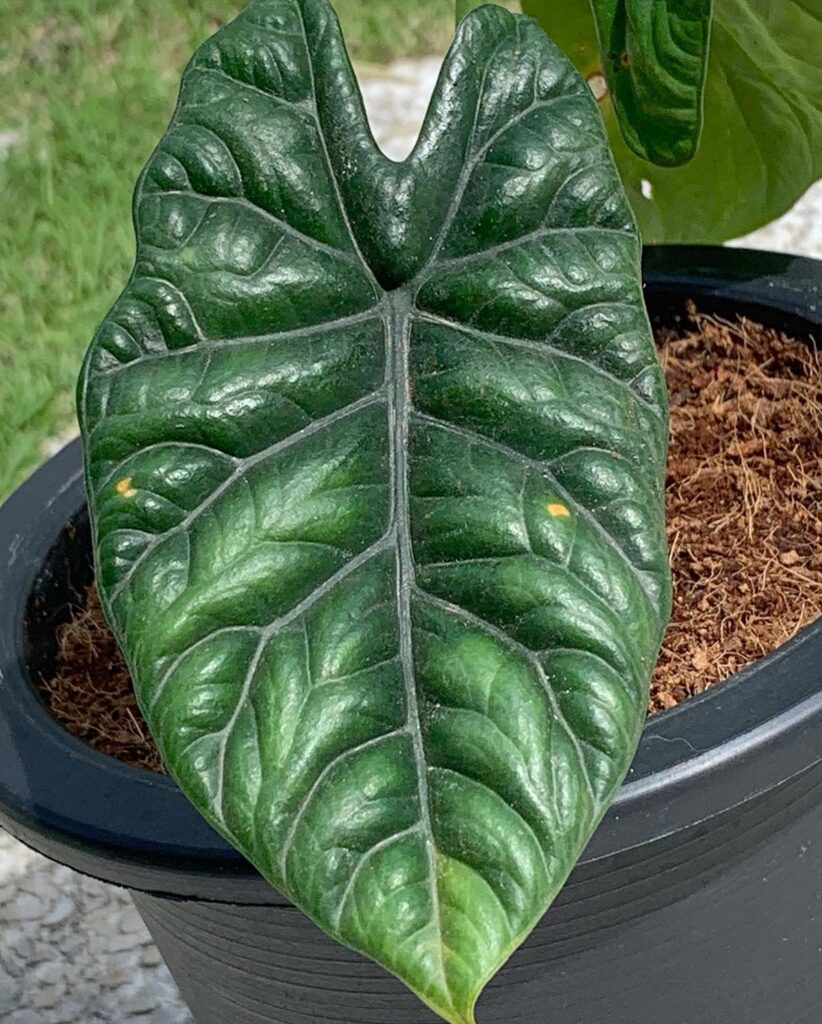
Just under 14 inches tall, this Philippine endemic has around 7 arrowhead to egg-shaped leaves that can be peltate (shield-shaped) or not. They range from 9-11 inches long with wavy, sometimes blistered margins in a deep green color, paler below. The petioles are around 7.5 inches long.
Alocasia suhirmaniana
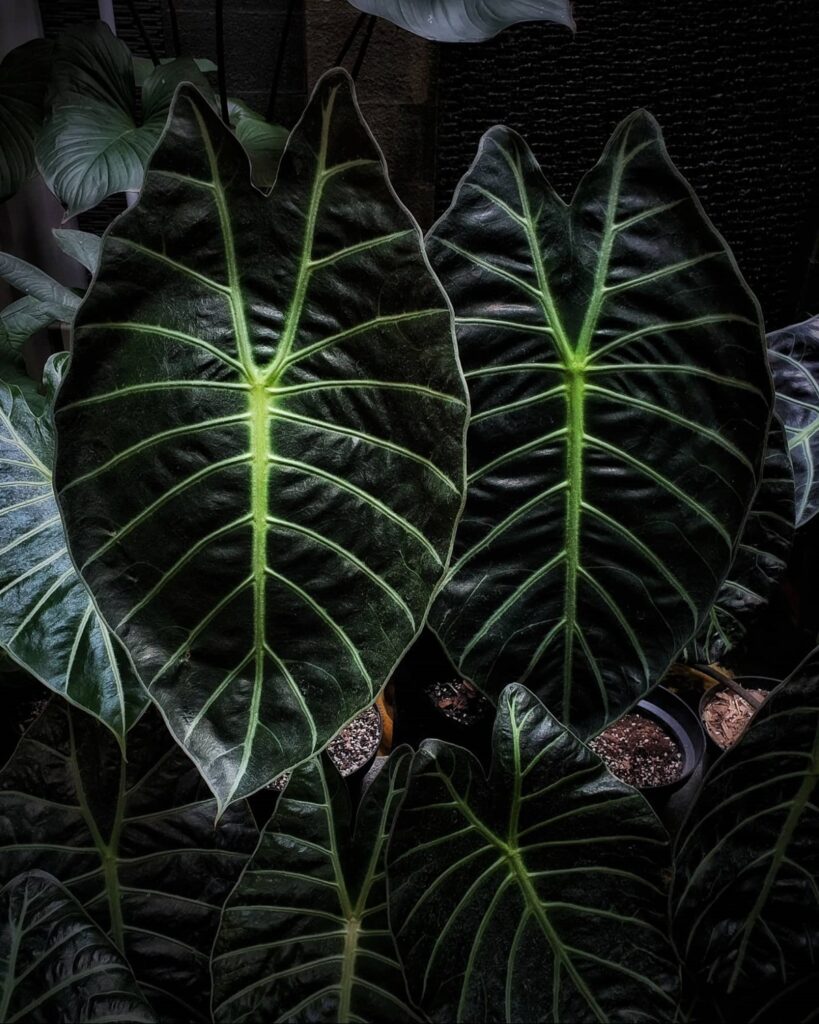
A terrestrial Indonesian herb with 1-3 broadly egg-shaped, peltate leaves that point downwards. They have slightly wavy margins and are up to 14×10 inches, with a glossy dark green, yellow-veined topside and dark purple underside. The yellowish-green petioles can reach 2 feet long and are densely speckled with purple-brown.
Alocasia tandurusa
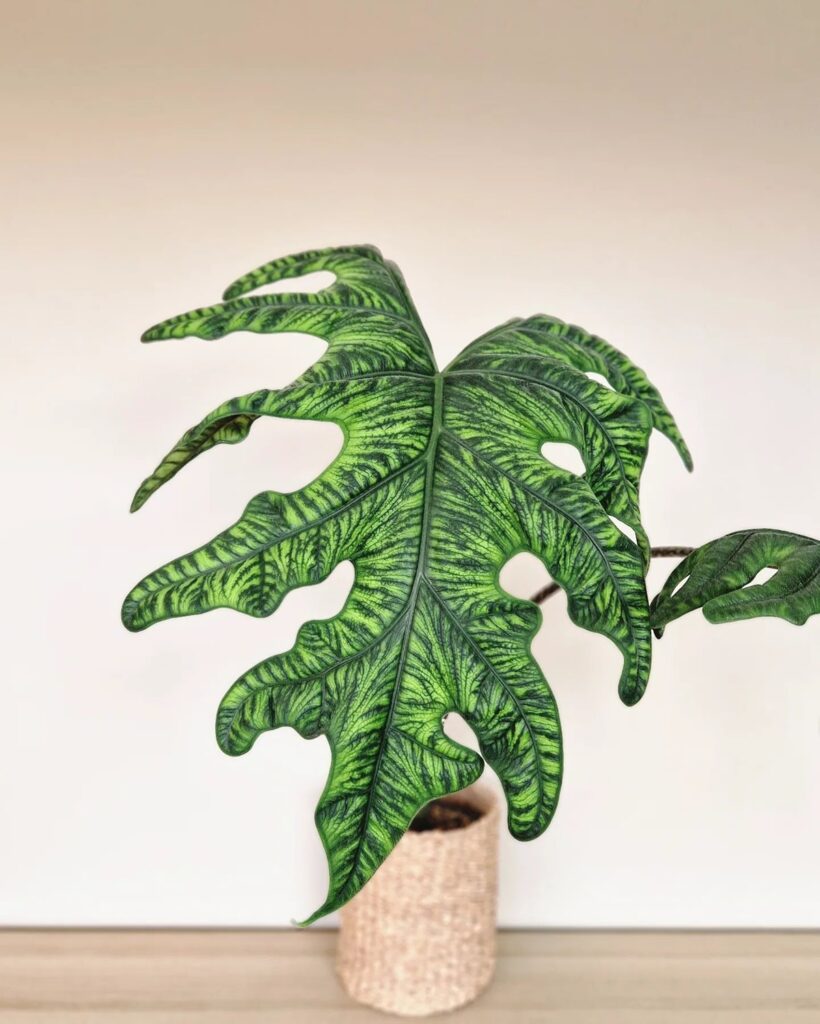
This Sulawesi native has a really cool shredded or pinnatifid leaf pattern, with the lobes extending over halfway to the midrib and sometimes even sub-divided into smaller lobes! The arrowhead-shaped leaves can reach 28 inches long and have a glossy dark green topside with purple undersides. The petioles get up to 30 inches tall and are speckled with brown or purple. Unfortunately, wild populations are being depleted by overcollection.
Alocasia venusta
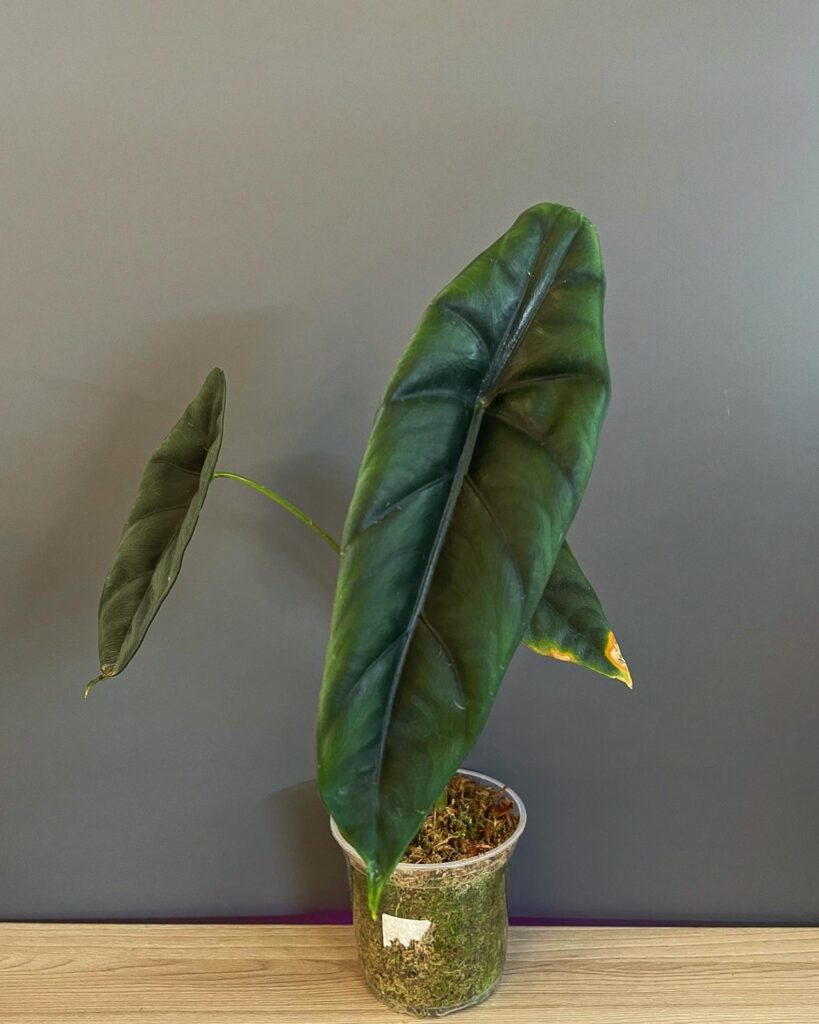
A petite 18-inch tall lithophyte (rock-dweller) from the Niah Caves area of Sarawak, Borneo. It has up to 6 stiffly leathery, oblong bluish-green leaves clustered together, around 11-14 inches long. The velvety dark leaves have 3 major veins per side. The rhizome is just 1 inch wide!
Alocasia vietnamensis
One of the few Alocasia species with a stipitate (stalked) spadix and staminodes on the female flower zone. This Vietnamese evergreen grows 28-32 inches tall with bright grayish-green leaves up to 13 inches long. The leaf undersides are even brighter gray. A unique species found only in one locality.
Alocasia wentii
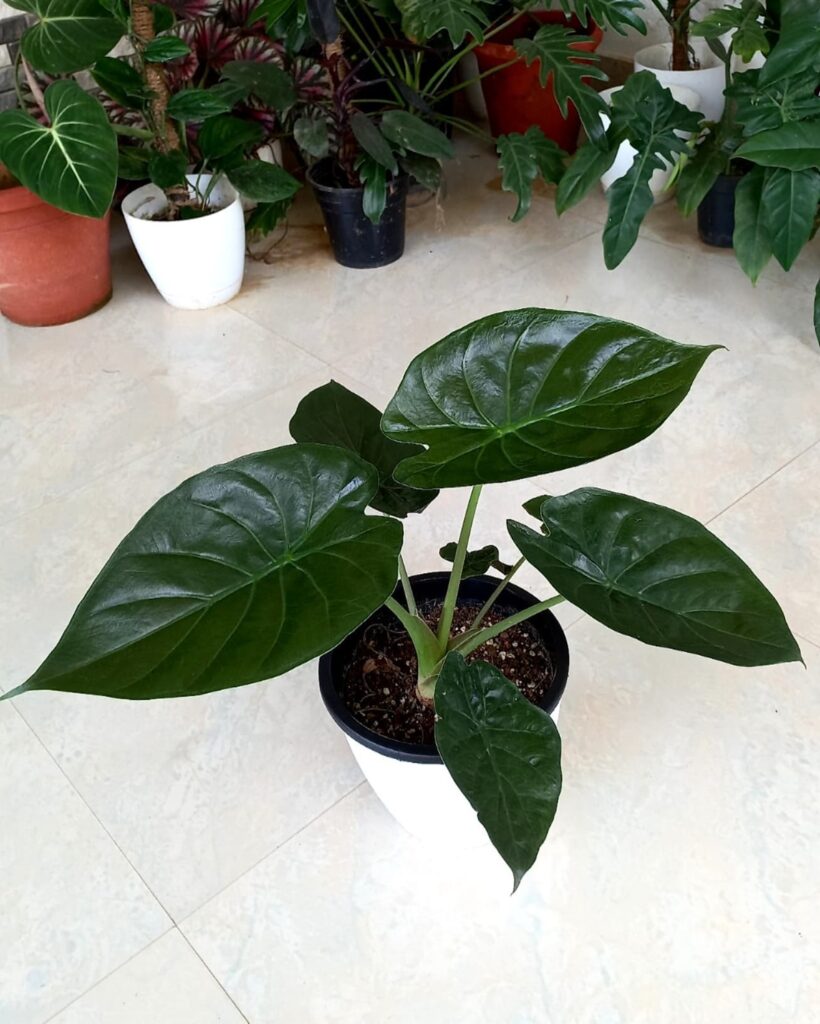
A tiny 6-inch tall mount rainforest herb with sagittate (arrowhead) leaves much shorter than the 8 inch slender, blue-streaked petioles. Leaves are dark green and rough-textured on top. Found only in a few remote mountain ranges in New Guinea and West Papua at higher elevations.
Alocasia wongii
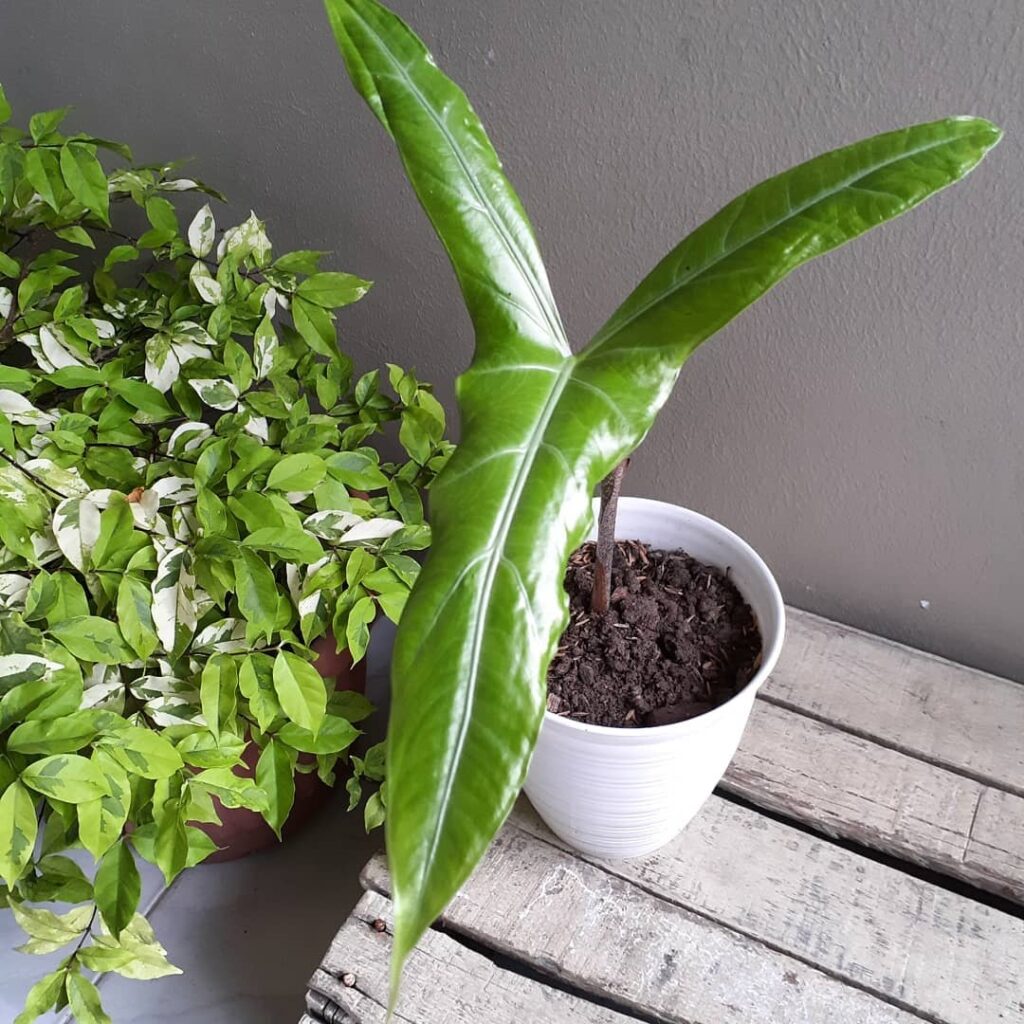
A slender 2-3 foot tall terrestrial Bornean species with arrowhead or spearhead leaves up to 2/3 as long as the petioles. The narrow, triangular leaf blades are dark grayish-green on top and paler below with a pinkish tinge near the base of the 8-18 inch mottled petioles.
Alocasia yunqiana
Now this is a massive, tree-like giant from Yunnan, China reaching 6-7 feet tall! The broad arrowhead to egg-shaped leaves span a huge 4 feet across and are smooth, dull green topside. The petioles get up to 3 feet long as well. This is a unique species that was only recently discovered in the Tongbiguan Nature Reserve.
Alocasia zebrina
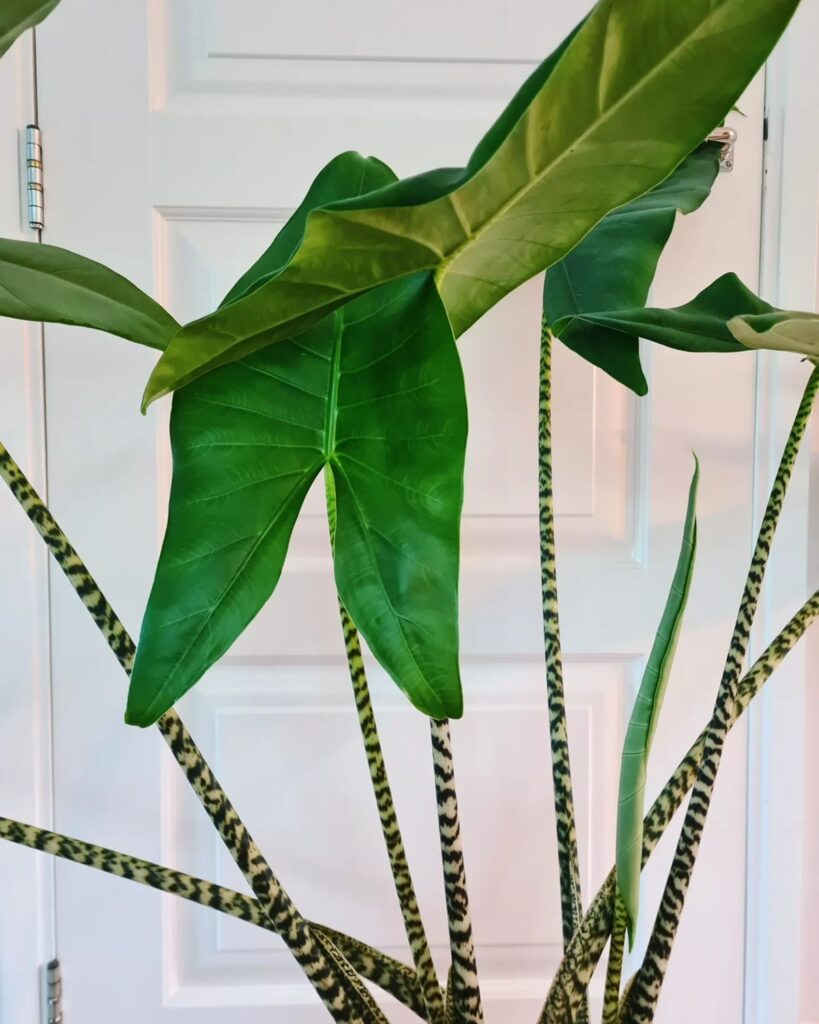
A moderately robust to large 6 foot tall Philippine species with narrowly arrowhead-shaped leathery leaves up to 3 feet long and over 2.5 feet wide. The glossy rich green leaves have 4-10 major veins per side. Petioles reach nearly 4 feet with oblique brown/green streaking and can be quite stout and succulent. Found across the Visayan islands.
Alocasia Plant Care Guide
Light Requirements
Alocasia plants thrive in bright, indirect light. They can tolerate a bit of direct sunlight, but too much can scorch their leaves. If you notice the leaves turning yellow, it might be a sign they’re getting too much direct sunlight.
Watering
These plants love moisture but hate being waterlogged. Water your Alocasia when the top inch of the soil feels dry. Be sure to use well-draining soil and a pot with drainage holes to prevent root rot.
Humidity
Alocasia plants are tropical and prefer high humidity. Mist the leaves regularly, or place the pot on a tray filled with water and pebbles to increase humidity. During the drier months, consider using a humidifier.
Temperature
Keep your Alocasia in a warm environment. They prefer temperatures between 65°F and 80°F (18°C to 27°C). Avoid placing them in drafty areas or near cold windows during winter.
Fertilizing
Feed your Alocasia with a balanced, water-soluble fertilizer every two to four weeks during the growing season (spring and summer). Reduce feeding during the fall and winter when the plant’s growth slows down.
Pruning
Prune any yellow or damaged leaves to keep your Alocasia looking its best. Use clean, sharp scissors to prevent infection and help the plant focus its energy on healthy growth.
Pests and Diseases
Keep an eye out for common pests like spider mites, aphids, and mealybugs. If you notice any pests, treat the plant with insecticidal soap or neem oil. Ensure good air circulation and avoid overwatering to prevent fungal issues.
Repotting
Repot your Alocasia every 1-2 years or when it outgrows its current pot. Choose a pot that’s one size larger and use fresh, well-draining soil. Spring is the best time to repot, as the plant will be entering its active growth period.
Dormancy
Alocasia plants may enter a period of dormancy in the fall and winter. During this time, reduce watering and fertilizing, and expect some leaf drop. When spring arrives, gradually increase watering and feeding as new growth begins.
Following these guidelines will help you keep your Alocasia plant healthy and thriving. Enjoy the beauty and elegance it brings to your space!
